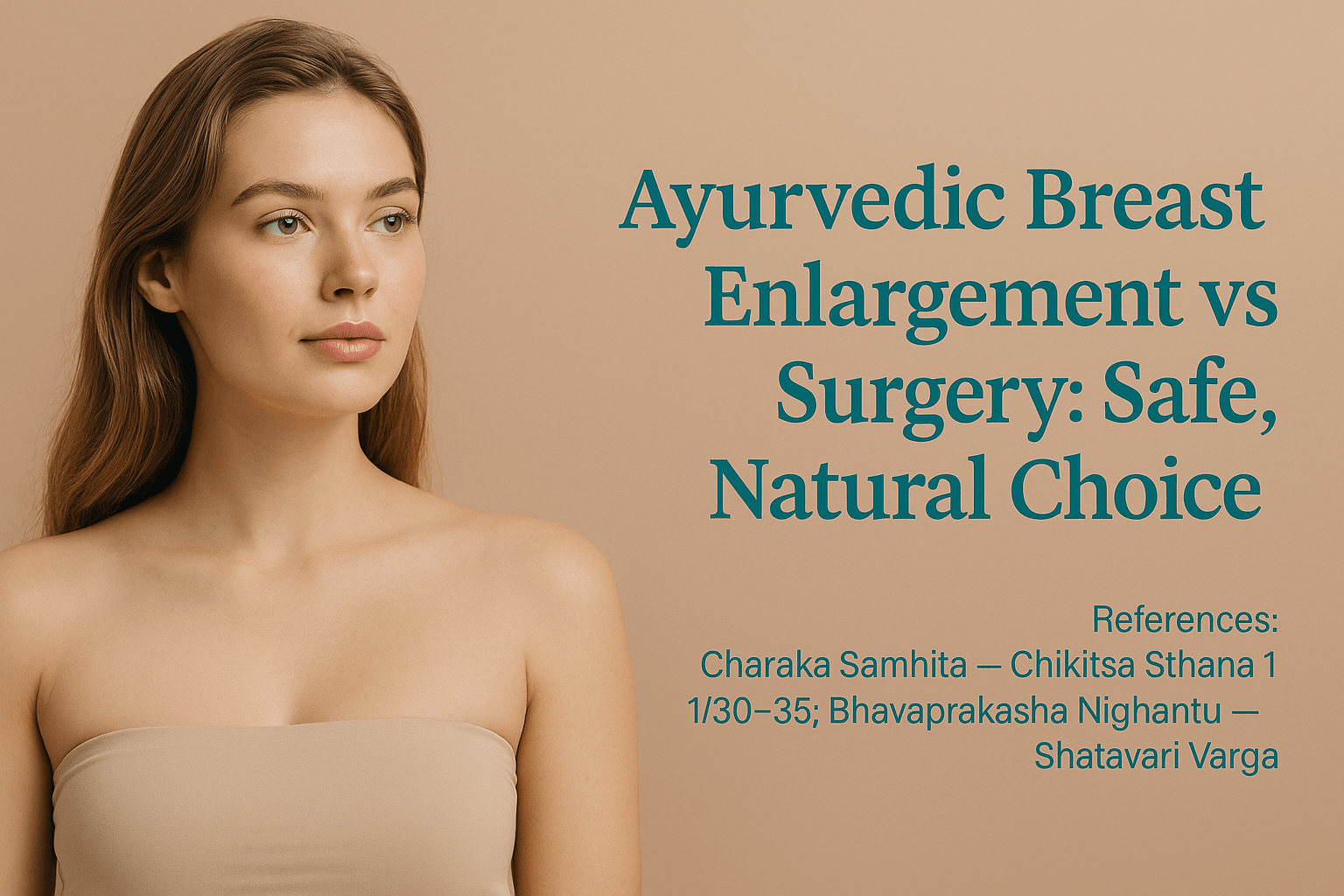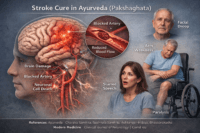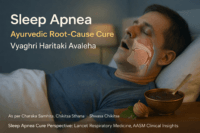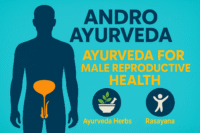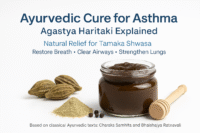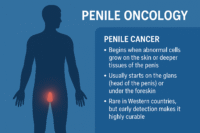- The Illusion of Quick Results
- Body and Mind: One Evolution
- A Safer, Sustainable Approach
- Psychological & Sociocultural Roots of Body Image
- Understanding Breast Anatomy & Hormonal Physiology
- Categories of Enlargement Methods
- Mechanisms of Action Compared
- The Latest Surgical Trends and Their Realities (2023–2025)
- The Ayurvedic Science of Natural Enhancement
- Classical Foundations of Enhancement
- Modern Correlations: How It Works Biochemically
- Comparative Pros and Cons: Surgical vs Ayurvedic Enlargement
- Long-Term Safety, Hidden Costs & Ethics
- Hormonal Harmony and Reproductive Health
- Skin Quality, Collagen & Anti-Aging Support
- Patient Safety: Regulation, Research, and Transparency
- The Future of Aesthetics: Regeneration through Nature
- Global Shift from Correction to Regeneration
- Rasayana Chikitsa: The Ancient Blueprint of Regenerative Medicine
- Real-World Guidance: Choosing the Right Path
- Frequently Asked Questions
- References
Understanding the Desire for Enhancement
Ayurvedic Breast Enlargement- Across the world, countless women quietly share the same wish to feel more confident and feminine in their own skin. Breast size often becomes a symbol of youth, fertility, and attractiveness, shaped not only by biology but also by cultural ideals and media influence. From glossy magazines to filtered social feeds, society subtly teaches that “perfection” has a specific shape. Many women therefore begin searching for enlargement methods, hoping to align outer appearance with inner self-esteem (12).
Yet the desire is rarely just about appearance. For some, it arises after pregnancy or weight loss, when hormonal changes alter firmness or volume. For others, it follows years of low confidence or the wish to correct asymmetry. These are deeply personal motivations, not vanity. In Ayurveda, such feelings are understood as an expression of the natural human wish for Saundarya—balanced beauty born from harmony within (4).
The Illusion of Quick Results
Modern advertising often promises rapid transformation—“instant curves,” “30-day lift,” or “permanent results.” While these phrases appeal to emotion, they hide biological truths. Surgical implants or synthetic hormones can indeed change appearance quickly, but they do not nurture hormonal balance or tissue vitality. The effect may appear dramatic but is often temporary or burdened with side effects (18).
Ayurveda views the body as an intelligent ecosystem. It teaches that every visible structure—including breast tissue—reflects the health of deeper systems: Rasa Dhatu (plasma), Mamsa Dhatu (muscle), and Shukra Dhatu (reproductive essence) (5). When these are nourished naturally through proper diet, herbs, and rest, shape and tone improve steadily and safely. Real confidence grows from this biological harmony, not from surgical speed.
Body and Mind: One Evolution
The classical Ayurvedic doctrine Sharira–Manas–Sattva Samya explains that the body (Sharira), mind (Manas), and consciousness (Sattva) evolve together. When any one is disturbed—for example, when constant comparison on social media distorts self-image—the others lose balance (7). Rejuvenation therefore begins not with an operating table but with mental stillness, balanced hormones, and cellular nourishment.
Modern psychoneuroendocrine research supports this view: stress hormones such as cortisol suppress estrogen and growth factors that maintain healthy breast tissue (26). Thus, inner peace literally supports outer beauty. Herbs like Shatavari and Ashwagandha, known for calming the mind while balancing female hormones, embody this link between serenity and structure (9).
A Safer, Sustainable Approach
While modern procedures focus on visible volume, Ayurveda focuses on Ojas—the subtle energy that sustains vitality, immunity, and radiance. A woman whose Ojas is strong glows with confidence regardless of size. Non-surgical Ayurvedic therapies gradually rebuild this internal reserve, improving not only physical form but also emotional resilience.
This article invites you to understand both options—surgical and non-surgical—with clarity, compassion, and scientific insight. If you wish to explore how Ayurveda achieves enhancement safely and naturally, continue to our detailed guide:
Breast and Hip Enlargement Naturally with Ayurveda
Psychological & Sociocultural Roots of Body Image
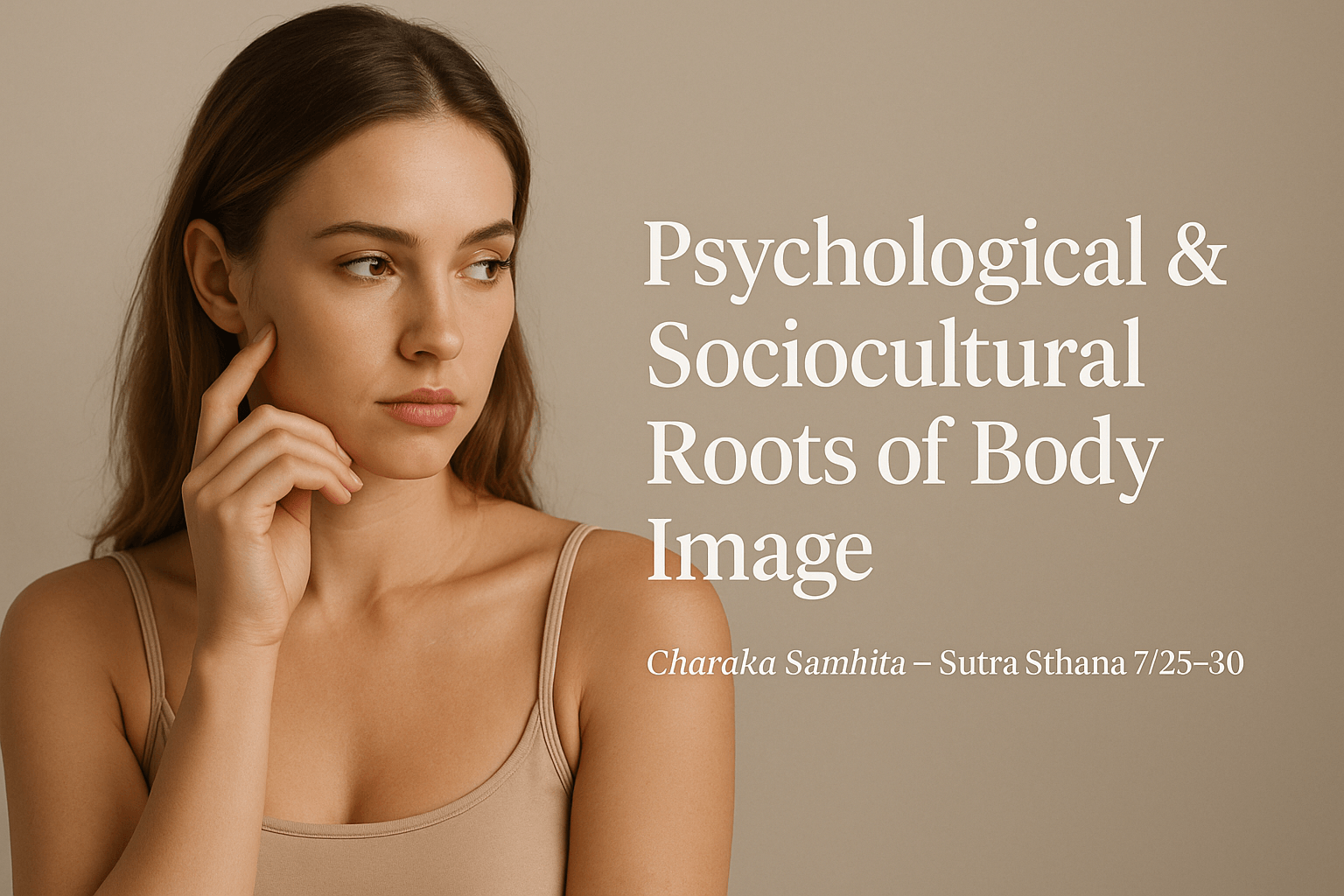
The Global Mirror: How Culture Shapes Self-Perception
Across continents, beauty ideals have quietly merged into one digital standard—symmetrical faces, flawless skin, and perfectly contoured figures.
Social media filters and AI-generated models amplify this illusion, making natural variation appear “imperfect” (14).
Women scrolling through endless curated images often begin comparing themselves unconsciously, measuring worth through likes and virtual validation.
This invisible pressure fuels a silent global struggle: the belief that confidence can be surgically manufactured rather than cultivated.
In truth, what most women seek is not perfection—but peace of mind and self-acceptance (23).
When Confidence Turns Into Comparison
Psychologists call this condition body dysmorphic tendency—a persistent dissatisfaction with one’s own image despite being objectively normal (31).
Studies show that exposure to digitally altered beauty on social media increases anxiety, lowers self-esteem, and promotes unhealthy decisions such as impulsive cosmetic procedures (17).
Women begin chasing a moving target, where “beautiful enough” never arrives.
Ayurveda interprets this mental turbulence as an imbalance of the subtle energies Rajas (restlessness, desire) and Tamas (inertia, confusion) (6).
When both dominate, clarity (Sattva) diminishes—leading to confusion about what truly defines beauty and self-worth.
The Hidden Pain Behind Post-Surgery Regret
Modern surveys reveal that up to one-third of women who undergo cosmetic breast surgery later experience regret, anxiety, or a feeling of detachment from their own body (22).
Many describe a strange emotional disconnect—admiring the shape in the mirror yet feeling less “themselves.”
Psychologists now term this implant identity crisis: the subconscious discomfort of having confidence dependent on an external object rather than internal wholeness (29).
Ayurveda forewarned of this centuries ago. It teaches that artificial modifications which disturb the body’s natural balance may create Agantuja Vikara—conditions arising from foreign interference (8).
Such imbalance doesn’t just disturb the tissues; it unsettles the mind.
Returning to Balance: The Ayurvedic Perspective
In Ayurvedic philosophy, lasting beauty emerges from harmony between the three mental energies—Sattva (clarity), Rajas (desire), and Tamas (inertia).
When Sattva predominates, a person radiates calm confidence that requires no external validation (10).
Therapies such as Brahmi, Ashwagandha, Shankhpushpi, and mindful Pranayama are recommended to restore this inner clarity before beginning any enhancement program.
The goal is not to suppress desire for improvement but to ensure that motivation arises from self-care, not self-criticism.
Self-Reflection: Enhancement or Reconnection?
Before deciding on any enlargement path—surgical or Ayurvedic—it helps to pause and ask a few honest questions:
- Am I seeking change because I feel incomplete or because I want to celebrate my femininity?
- Do I compare myself constantly to others on social media?
- Would natural, gradual improvement make me equally happy if it aligned with health and safety?
- Am I investing in appearance, or am I reconnecting with self-confidence?
If the answer leans toward self-reconnection, Ayurveda offers the gentler route.
It encourages awareness, acceptance, and steady transformation—beauty that grows out of balance rather than surgery that forces the body into it.
Understanding Breast Anatomy & Hormonal Physiology
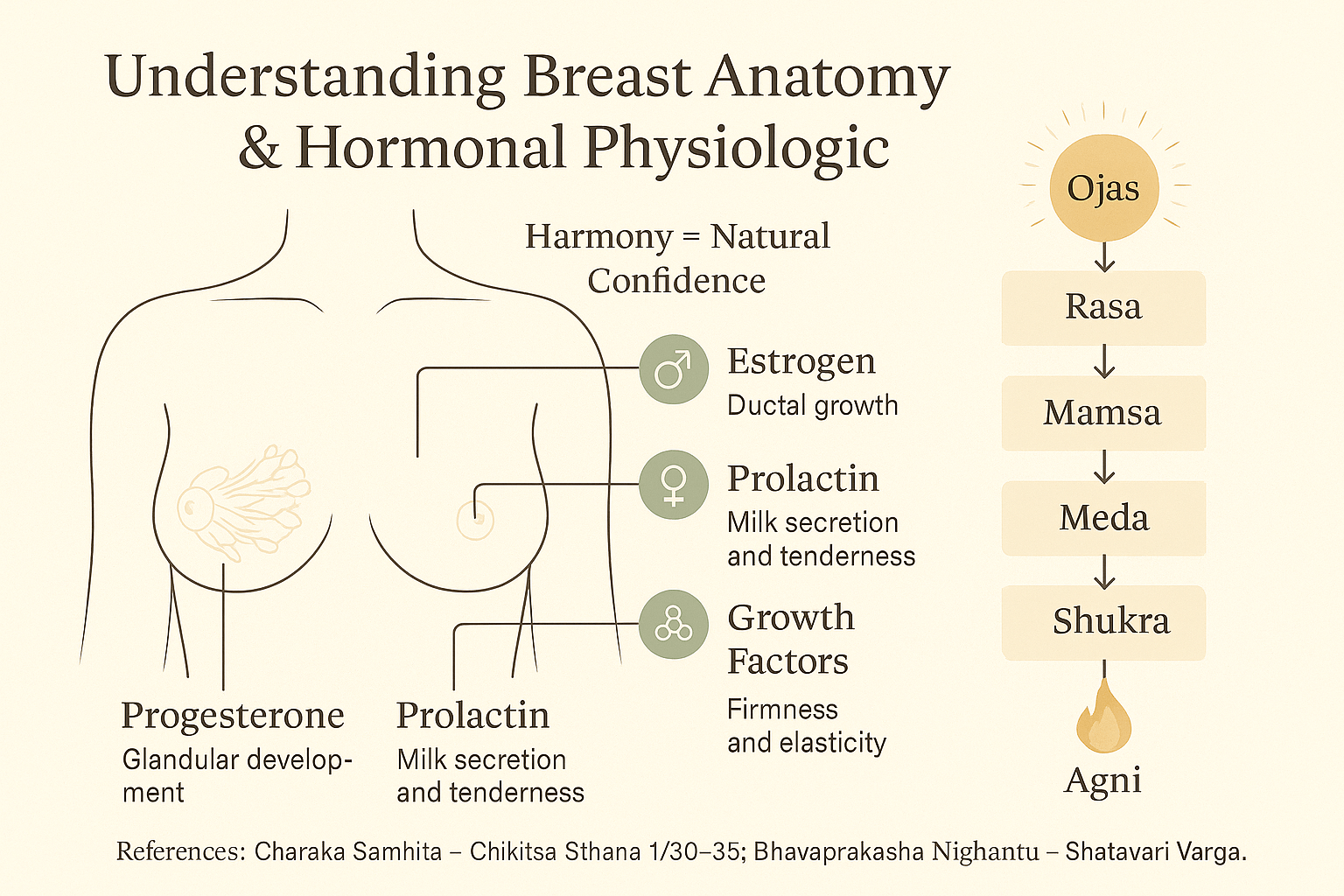
The Science Behind Shape and Function
Breast tissue is not merely an ornament of femininity; it is a living organ dynamically shaped by hormones, metabolism, and emotional health. From puberty through adulthood, the female breast continually responds to subtle shifts in the endocrine system. Hormones like estrogen, progesterone, and prolactin direct this rhythm of development, fullness, and function (14).
Estrogen encourages the growth of ducts and connective tissue, giving contour and volume. Progesterone promotes the development of milk-producing lobules, preparing the body for potential motherhood (21). Prolactin, often called the “nurturing hormone,” supports lactation and influences tenderness, reflecting the body’s readiness to nourish life (9).
Modern research also highlights the role of growth factors and adipokines—cell messengers that regulate fat distribution and elasticity. These determine firmness, while collagen and elastin fibers maintain youthful texture. When this hormonal harmony is disturbed by stress, poor diet, or synthetic drugs, the breast loses tone and sensitivity (26).
The Ayurvedic Understanding of Breast Tissue
Thousands of years before hormonal science emerged, Ayurveda had already mapped this intricate relationship through the concept of Dhatus—the seven tissues that sustain life. In the Ayurvedic framework, the breast corresponds primarily to the nourishment and strength of four key Dhatus:
- Rasa Dhatu (plasma): provides initial nutrition and fluidity.
- Mamsa Dhatu (muscle): gives firmness and contour.
- Meda Dhatu (adipose tissue): maintains softness and luster.
- Shukra Dhatu (reproductive essence): governs hormonal strength and femininity (7).
Each Dhatu feeds the next through a sequence known as Dhatu Poshan Nyaya—the law of tissue nourishment. When digestion (Agni) is strong, nutrients transform efficiently, flowing from Rasa to Mamsa, to Meda, and finally to Shukra (11). The result is natural fullness, glow, and balance.
If this chain weakens—through poor digestion, emotional strain, or toxin buildup (Ama)—breast tissue may become undernourished, sagging, or tender.
Agni, Ojas, and the Essence of Radiance
Ayurveda identifies Agni (digestive fire) as the origin of all metabolic intelligence. It converts food into energy, and that energy, when refined, becomes Ojas—the subtle essence of vitality. Ojas governs immunity, hormonal rhythm, and emotional stability (17).
In women with abundant Ojas, the skin glows, hair shines, and breasts appear naturally firm and proportionate, regardless of size. Conversely, chronic fatigue, crash dieting, or emotional distress can deplete Ojas, leading to dullness, dryness, and hormonal irregularities (28).
Herbs like Shatavari, Ashwagandha, Vidari, and Amalaki are traditional Rasayanas prescribed to rebuild Ojas and restore harmony between metabolism and tissue health (30). These not only enhance physical tone but also balance mood and reproductive strength—qualities often lost after synthetic hormone use or cosmetic intervention.
Bridging Modern Endocrinology and Ayurvedic Physiology
Modern endocrinology speaks of hormones; Ayurveda speaks of Dhatus and Agni. Yet both describe the same reality through different languages. Estrogen’s nurturing role mirrors Rasa’s nourishing quality; progesterone’s stabilizing function reflects Mamsa’s firmness; prolactin’s maternal influence corresponds to Shukra’s creative essence.
This bridge between ancient and modern wisdom reveals a shared truth: hormonal balance and emotional stability cannot be separated from tissue health (19).
Thus, the path to enhancement—whether for volume, tone, or wellness—must honor both physical and energetic nourishment. Surgery can reshape, but only holistic nourishment can rejuvenate.
Categories of Enlargement Methods
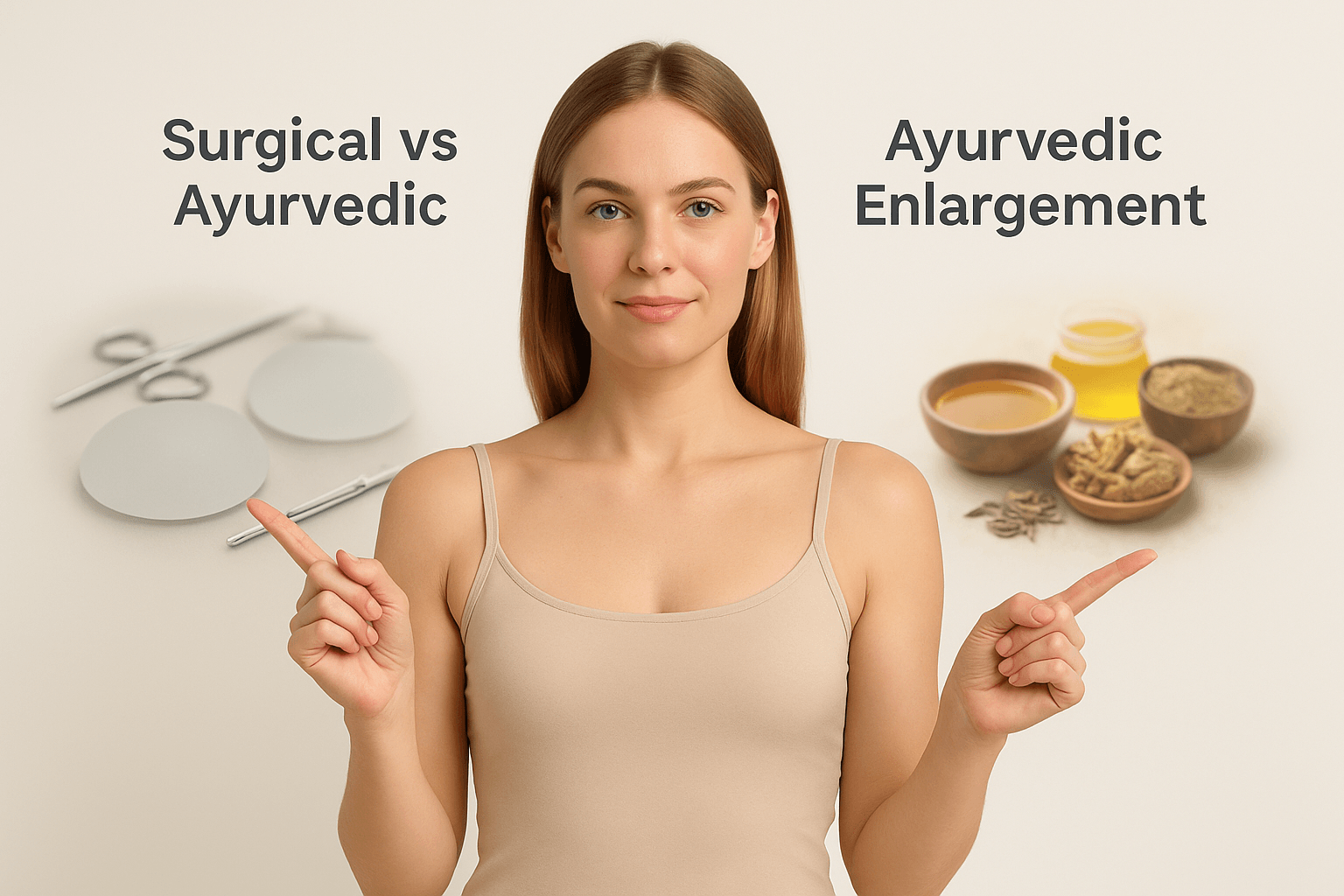
4.1 Surgical Techniques
Different Implant Types and Their Mechanisms
Surgical breast augmentation remains the most commonly performed cosmetic procedure worldwide. The most popular implant materials include silicone, saline, and hydrogel, each offering a different texture and appearance (14).
- Silicone implants are filled with cohesive gel that mimics natural tissue softness but may cause immune reactions or capsular tightening over time.
- Saline implants are filled with sterile saltwater, allowing volume adjustment but often feel less natural and may ripple under thin skin (21).
- Hydrogel implants, containing water and polymer gel, are marketed as “eco-safe,” though long-term data on tissue response remain limited (29).
These devices are inserted either beneath the breast tissue (subglandular) or behind the chest muscle (submuscular). The body naturally forms a fibrous capsule around them—a protective response that, in some cases, leads to capsular contracture, making the breast feel firm or painful (23).
Evolving Techniques: Fat Grafting and Hybrid Surgery
Recent years have witnessed a growing interest in fat transfer (autologous fat grafting), where the patient’s own fat is harvested via liposuction and injected into the breasts. This approach provides softer contours and avoids synthetic implants. However, its results depend heavily on how much grafted fat survives. Resorption rates can reach 40–60%, leading to asymmetry, lumps, or calcifications (25).
To counter this, hybrid augmentation—a combination of implants and fat grafting—has become a trend. Surgeons use implants for volume and fat layers for softness. Although this improves appearance, it increases operation time, cost, and the risk of fat necrosis (32).
Cutting-Edge Advances (2023–2025)
New materials and planning tools have entered the market in recent years:
- Motiva® and Ergonomix2™ implants: Featuring SmoothSilk™ surfaces and adaptive gel for “natural movement,” now FDA-cleared for U.S. use (34).
- AI-guided surgical planning: 3D visualization software predicts outcomes and assists surgeons in size selection (30).
- Mesh scaffolds (internal bra systems): Biodegradable meshes or pig-dermal scaffolds used to prevent sagging and support implants (27).
While these innovations sound promising, they do not eliminate fundamental risks such as infection, rejection, or emotional detachment after surgery. Many women report “implant fatigue,” where repeated procedures lead to physical and psychological exhaustion (19).
Stem-Cell and Regenerative Adjuncts
Some centers now market stem-cell-enriched fat grafting, claiming longer-lasting results. The procedure involves combining adipose-derived stem cells (ADSCs) with fat before injection. However, clinical consensus remains cautious, as stem cells may theoretically stimulate dormant tumor cells or create unwanted fibrosis (35).
Without long-term safety studies, such regenerative claims remain experimental.
Ayurvedic Reflection on Surgical Methods
From the Ayurvedic viewpoint, all surgical implants are considered Agantuja Upadravas—foreign interventions that alter natural tissue intelligence. Surgery may reshape but cannot harmonize Agni (metabolism) or rebuild Ojas (vital essence). Ayurveda accepts surgical methods (Shastra Karma) only when necessary for survival or severe deformity, not for cosmetic pursuit (8).
Where surgery forces rapid change, Ayurveda cultivates gradual transformation through nourishment, detoxification, and emotional grounding.
4.2 Non-Surgical Methods
Modern Non-Invasive Approaches
Several non-surgical methods are promoted for breast enlargement:
- Hormonal creams and pills: Contain synthetic estrogens or phytoestrogens that mimic natural hormones. Short-term swelling may occur, but discontinuation often reverses results and may cause hormonal imbalance or weight gain (26).
- Herbal supplements: Western markets feature blends with fenugreek, fennel, and wild yam. Their efficacy varies widely depending on standardization and digestive absorption.
- Suction or vacuum devices: Temporarily stretch tissue but may cause bruising and sagging when overused (17).
- Exercise-based enhancement: Chest-focused workouts can tone pectoral muscles beneath the breast but do not increase actual breast tissue volume (9).
While these approaches appear safer than surgery, many remain superficial, targeting appearance without addressing internal hormonal and nutritional foundations.
Ayurvedic Rasayana and Herbal Rejuvenation Therapies
Ayurveda provides a complete non-surgical approach rooted in the regeneration of Dhatus (tissues) and the balance of Doshas.
- Shatavari (Asparagus racemosus): The primary Stanya-janana herb, enhances estrogenic balance and nourishes Shukra Dhatu, supporting natural fullness (5).
- Vidari (Ipomoea digitata): Builds Mamsa Dhatu and restores elasticity, preventing sagging (7).
- Yashtimadhu (Glycyrrhiza glabra): Improves collagen synthesis and skin tone.
- Abhrak Bhasma (Purified mica ash): Enhances cellular regeneration and hormonal equilibrium (15).
- Rasayana Avalehas (tonics): Such as Shatavaryadi Avaleha and Vidaryadi Avaleha, strengthen metabolism, improve nutrient assimilation, and build natural curves over time.
Ayurveda also integrates oil-based therapies (Sneha Abhyanga) and dietary Rasayanas—warm milk, ghee, almonds, and dates—to promote Ojas and tissue harmony.
Unlike modern cosmetic methods, these therapies are customized according to Prakriti (body type), age, and mental state. Results are gradual but permanent, as they emerge from restored internal balance rather than external alteration.
Mechanisms of Action Compared

Understanding how each method works is essential before making any decision about breast enhancement. Both surgical and non-surgical (Ayurvedic) methods influence the body, but in completely different ways — one by external modification, the other through internal regeneration.
1. Surgical Mechanism – Structural Alteration
Surgical augmentation acts primarily through mechanical reshaping. Implants or fat grafts are inserted beneath the breast tissue to instantly increase size and projection. The body reacts by forming a fibrous capsule around the foreign object — a natural defense response. While this gives volume, it can also lead to tissue tension, capsular contracture, or sensory changes over time. The improvement is cosmetic, not physiological, as the tissue itself does not regenerate or strengthen (14). The outcome depends on material compatibility, surgical precision, and post-operative healing. Essentially, surgery works on the body, not with it.
2. Hormonal and Cellular Response After Surgery
After surgical intervention, the body experiences localized inflammation and temporary hormonal disruption. Healing releases cytokines and growth factors, which sometimes alter tissue metabolism or cause minor lymphatic congestion (19). In long-term cases, repeated surgeries can fatigue the tissue’s elasticity, creating a sense of heaviness or tightness unrelated to natural balance.
3. Ayurvedic Mechanism – Cellular Regeneration and Dhatu Nourishment
Ayurveda enhances form by working through cellular nutrition and hormonal harmony, not structural insertion. It strengthens the sequence of Dhatu regeneration — from Rasa (plasma) to Mamsa (muscle) to Meda (fat) and finally to Shukra (reproductive essence) (7).
When this natural tissue chain is nourished, the breast develops gradual fullness and tone. Ayurvedic Rasayanas, such as Shatavari, Vidari, and Ashwagandha, restore the body’s hormonal rhythm while enhancing Agni (metabolic fire). This process ensures that the transformation is both internal and sustainable, arising from restored tissue health rather than forced volume.
4. Neuroendocrine Balance and Ojas Formation
Unlike the external approach of implants, Ayurveda works through the neuroendocrine axis — harmonizing the pituitary, thyroid, and adrenal systems that govern estrogen and prolactin secretion (11). Balanced Agni produces pure Rasa Dhatu, which transforms into Ojas, the essence responsible for radiance, vitality, and emotional balance. The result is not just visible enlargement but improved breast tone, skin texture, and psychological well-being. Thus, Ayurveda treats beauty as a reflection of internal equilibrium rather than external design.
5. Comparative Insight
- Surgery: Works mechanically, immediate but external.
- Ayurveda: Works biologically, gradual but permanent.
- Surgery: Alters shape without nourishing tissues.
- Ayurveda: Rebuilds tissues, restoring strength, elasticity, and confidence.
The Latest Surgical Trends and Their Realities (2023–2025)

Balanced, patient-friendly analysis of what’s new in breast augmentation—followed by an Ayurvedic contrast that prioritizes safety, sustainability, and inner balance. Citations are numbered; full references follow.
6.1 Motiva® & Ergonomix2™ Implants — promise vs. reality
What’s new (2024–2025): The U.S. FDA cleared Motiva SmoothSilk® Round and Ergonomix® silicone gel–filled implants in late 2024, based on an open-label prospective study with up to 3-year follow-up (1). Company notes highlight “softer feel,” adaptive gel, and a micro/nano-textured envelope that aims to reduce capsular contracture (2).
Clinical reality: Early U.S. data extend only to ~3 years, so 10–15 year durability and rupture rates are not yet known (1). Meanwhile, literature around breast implant illness (BII)—a heterogeneous symptom cluster (fatigue, joint pain, brain fog)—continues to grow; symptom improvement after explant is reported in many patients despite the absence of a single diagnostic test (3,4).
Key risks to discuss: delayed rupture/silicone bleed, capsular contracture, reoperation; possible systemic symptoms captured under BII (3,4).
Ayurvedic contrast: Ayurveda cautions against foreign materials (Agantuja upadrava) that can provoke long-term tissue reactivity. Instead of inserting volume, classical care nourishes Rasa → Mamsa → Meda → Shukra through Rasayana (e.g., Shatavari, Vidari) while preserving Ojas (vital essence). See Charaka Saṃhitā, Chikitsā Sthāna 1/30–35; Bhāvaprakāśa Nighaṇṭu, Shatavari Varga (5,6).
6.2 Hybrid Surgery (Implant + Fat Transfer) — softer edges, added variables
What’s new: Combining implants with autologous fat grafting to soften edges and improve cleavage is increasingly common.
Evidence 2024: A meta-analysis of 35 studies (n=3,757) found overall complications 27.8% for fat grafting alone; fat necrosis comprised 43.7% of complications; average volume retention ~58% (7). Mechanistic reviews confirm fat necrosis and calcifications are common, which can complicate imaging (8,9).
Clinical reality: While the look can be natural, fat survival varies widely; nodules and oil cysts may require interventions; radiology must distinguish benign calcifications from pathology.
Ayurvedic contrast: Rather than relocating fat, Ayurveda builds tissue in situ by improving Agni and nourishing Dhatus. Rasayana avalehas (e.g., Shatavaryadi, Vidaryadi) and Sneha (medicated ghee/oils) aim for gradual, self-sustained fullness without graft loss or calcifications (5,6).
6.3 Internal Mesh “Internal Bra” Scaffolds — support with strings attached
What’s new: Biologic or synthetic meshes (absorbable P4HB, porcine dermal matrices) are used to create internal support (“internal bra”) and reduce ptosis.
Evidence 2025: Systematic and narrative reviews report complications including seroma, skin/fat necrosis, hematoma, wound issues, recurrent ptosis, capsular contracture and occasional implant/ nipple loss; evidence quality is mixed and heterogenous (10,11).
Clinical reality: Mesh can help select cases, but it adds foreign material and cost; infection, inflammation, or prolonged pain are not negligible.
Ayurvedic contrast: Ayurveda’s “internal support” is biological—strengthening collagen/elasticity with Amalaki and Guduchi, and firming via Mamsa-vardhana therapies and breast-focused abhyanga. No permanent foreign scaffold, hence no mesh-specific complications (5,6).
6.4 Stem-Cell–Enriched Fat Grafting — promise of biology, questions of safety
What’s new: Some centers enrich lipoaspirate with adipose-derived stem cells (ADSCs) or stromal vascular fraction to improve fat take.
Evidence: Reviews note no clear oncologic signal in general fat grafting to the breast (8), but ADSC enrichment remains cautious territory: theoretical tumor-promotion and fibrosis concerns persist, and regulatory frameworks vary (12,13,14).
Clinical reality: Considered experimental in many regions; informed consent must cover oncologic uncertainty, regulatory status, and cost.
Ayurvedic contrast: Rather than manipulating cell populations, Ayurveda pursues endogenous regeneration via Rasayana—gradual up-regulation of repair and immune balance while minimizing iatrogenic risk (5,6).
6.5 AI-Assisted Planning & 3D/AR Simulation — better previews, human expectations
What’s new: 3D simulation and AR tools help preview sizes and shapes.
Evidence 2024: Prospective data suggest improved preoperative understanding/satisfaction with information; postoperative satisfaction wasn’t reduced (15). Broader AI reviews show rapid tool adoption but emphasize the need for ethical guarding against over-promising (16).
Clinical reality: Visualizations are aids, not guarantees; tissue properties, healing, and capsular behavior still limit predictability. Unrealistic expectations can still lead to distress and regret if outcomes differ.
Ayurvedic contrast: Ayurveda begins with mind-body readiness—restoring Sattva (clarity) via adaptogens (e.g., Ashwagandha, Brahmi) and counseling, so decisions arise from calm self-regard, not digital ideals (5,6).
6.6 “Minimally Invasive” Techniques — smaller scars, same physiology
What’s new: Refined instruments, smaller incisions, endoscopic assists.
Evidence: Even cosmetic procedures carry iatrogenic peripheral nerve injury risk, though low; mechanisms include traction, compression, thermal injury (17). Older data show sensory changes can occur after augmentation (contextual evidence) (18).
Clinical reality: “Mini-scar” does not equal “no risk.” Anesthesia risks, sensory alterations, bleeding, and capsular responses remain possible.
Ayurvedic contrast: The Ayurvedic path avoids incision and anesthesia, prioritizing hormonal balance and tissue nutrition for improvements in tone and confidence without operative risk (5,6).
6.7 Maintenance & Revisions — the long tail of ownership
What’s new/ongoing: The FDA and professional bodies advise routine imaging (MRI/ultrasound) beginning 5–6 years after silicone implantation and every 2–3 years thereafter to detect silent rupture/leak (19,20). Core and long-term studies show substantial reoperation over 6–10 years (often 25–36%+), driven by capsular contracture, malposition, dissatisfaction, rupture, or size change (21–24).
Clinical reality: Augmentation is not a one-time event—expect monitoring, potential revisions, and future costs (including explant).
Ayurvedic contrast: No device = no surveillance MRI, no rupture risk, no revision cycle. Ongoing “maintenance” is lifestyle: diet, sleep, stress care, and periodic Rasayana to preserve results.
6.8 Psychological Impact & Decision Regret — the human core
What’s new: Surgical literature increasingly quantifies decision regret and psychosocial outcomes. A 2024 systematic review reported regret ranges up to ~47% in breast reconstruction cohorts and ~5–9% in augmentation cohorts (25,26). Reviews of implant complications note that a sizable fraction of revisions are linked to dissatisfaction in addition to medical indications (22,24).
Clinical reality: Many women are happy post-op—and a meaningful minority struggle with mismatch between image and identity, or with the burden of maintenance.
Ayurvedic contrast: By rebalancing Rajas/Tamas and elevating Sattva, Ayurveda aims to reduce post-decision regret: changes are gradual, reversible, and health-coupled, so confidence grows from alignment rather than attachment to an implant (5,6).
The Ayurvedic Science of Natural Enhancement
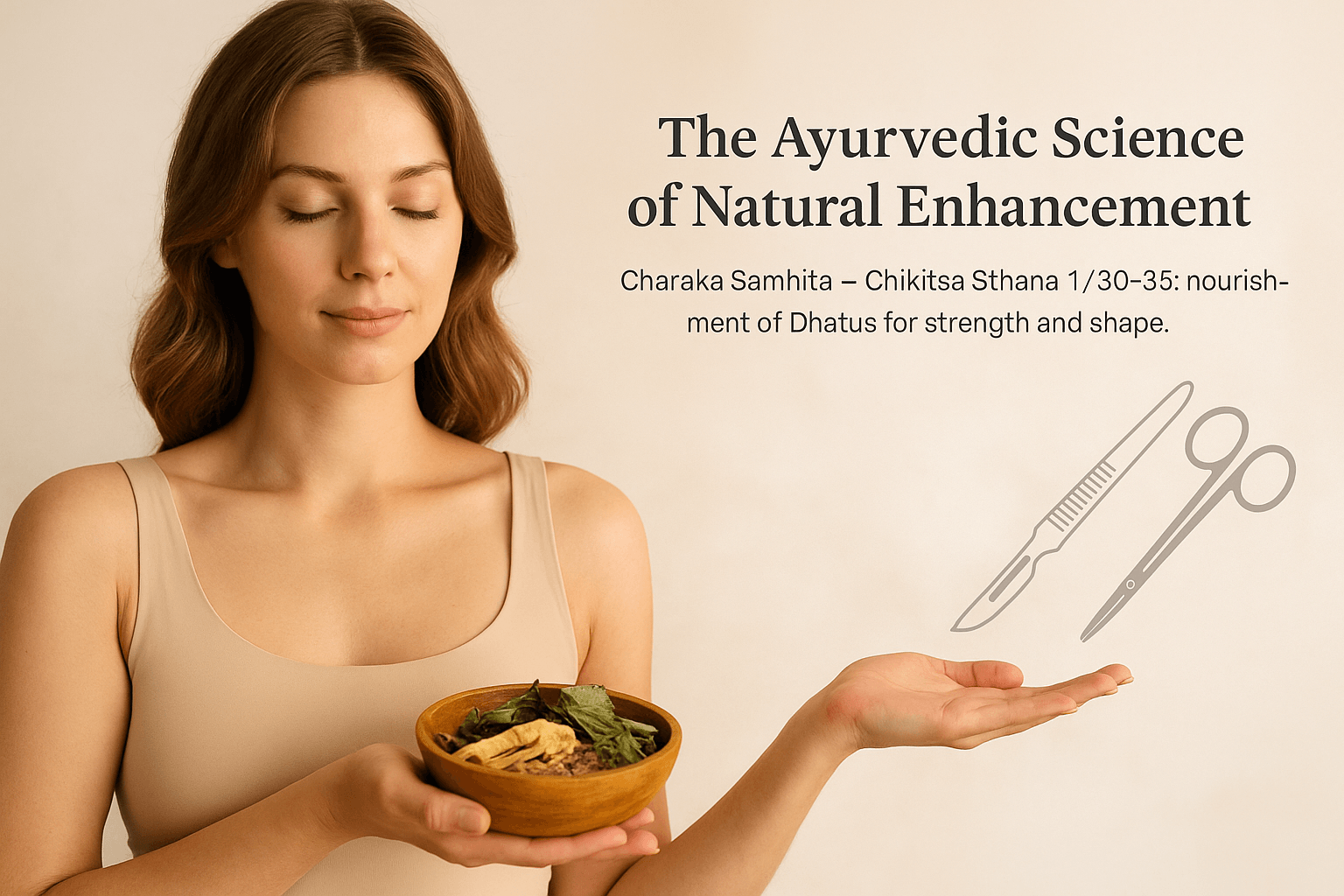
In Ayurveda, beauty and form are not cosmetic accidents but reflections of inner harmony. Breast size, tone, and vitality arise naturally from the balance of Dhatus—the body’s nourishing tissues—and the steady flame of Agni (metabolic fire). Modern science might describe these as hormonal, collagenic, and antioxidative networks, but Ayurveda recognized them centuries ago through subtle observation and clinical practice.
Classical Foundations of Enhancement
Charaka Samhita – Chikitsa Sthana 1/30–35 describes the sequential nourishment of Rasa, Rakta, Mamsa, Meda, and Shukra Dhatus, each layer contributing to structure, softness, and reproductive strength (42). When these tissues are fully nourished, the body expresses firmness and vitality from within—without surgical intervention or foreign materials.
Bhavaprakasha – Madhyama Khanda 12 identifies Stanya-Janana herbs such as Shatavari and Vidari, which not only enhance lactation but also enrich Mamsa and Meda Dhatus, promoting balanced development of breast tissue (43).
Bhaishajya Ratnavali – Rasayana Prakarana explains that Rasayana formulations rejuvenate all Dhatus, restoring youthful glow and tissue tone (44). This holistic rejuvenation becomes the Ayurvedic equivalent of cellular regeneration, achieved through herbs, minerals, and personalized therapies.
Modern Correlations: How It Works Biochemically
Modern biomedical studies mirror these ancient insights.
- Phytoestrogenic modulation: Compounds in Shatavari (Asparagus racemosus) and Pueraria tuberosa mimic mild estrogenic activity, naturally influencing breast tissue responsiveness and glandular density (45).
- Collagen synthesis: Herbs like Amalaki and Guduchi upregulate collagen formation, improving elasticity and tone (46).
- Antioxidant and anti-inflammatory protection: Ayurvedic Rasayanas neutralize oxidative stress, which is known to impair tissue repair and hormone balance (47).
Thus, what ancient texts call Mamsa-Meda-Shukra Pushti (tissue nourishment) aligns precisely with hormonal homeostasis, improved protein synthesis, and balanced lipid metabolism in modern physiology.
Personalization by Prakriti
Every woman’s body follows a unique Prakriti—a biological constitution governed by Vata, Pitta, and Kapha. Ayurveda teaches that enhancement cannot be universal; rather, it must honor these natural blueprints.
- Vata-dominant women often benefit from nourishing, grounding herbs (Shatavari, Ashwagandha, Yashtimadhu).
- Pitta-dominant women need cooling rejuvenators (Amalaki, Guduchi, Shankhapushpi).
- Kapha-dominant women respond best to metabolism-balancing tonics (Trikatu, Triphala) to avoid heaviness or stagnation.
This individualized approach ensures enhancement is safe, harmonized, and enduring, not driven by hormonal manipulation but by equilibrium.
Clinical Observations from Ayurvedic Practice
In clinical observation, women following a three-month Rasayana regimen—including Shatavari-based Avalehas and Abhyanga with medicated oils—often report gradual firmness, improved symmetry, and heightened confidence.
Patients also describe parallel benefits: better menstrual regularity, increased energy, and emotional balance. These outcomes underscore Ayurveda’s principle that true enhancement is a byproduct of systemic health, not a localized intervention.
Each case demonstrates how targeted nourishment of Rasa and Mamsa Dhatus restores both structure and vitality without surgery, hormonal therapy, or implants.
Ayurveda provides a complete biological framework for natural enhancement—rooted in metabolic balance, tissue regeneration, and mental tranquility. Where modern procedures alter the body externally, Ayurveda rebuilds it from the inside, through nourishment, not incision; through harmony, not haste.
For those seeking natural, lasting, and safe enhancement, this ancient science offers what surgery cannot: the confidence that grows from inner balance.
Comparative Pros and Cons: Surgical vs Ayurvedic Enlargement
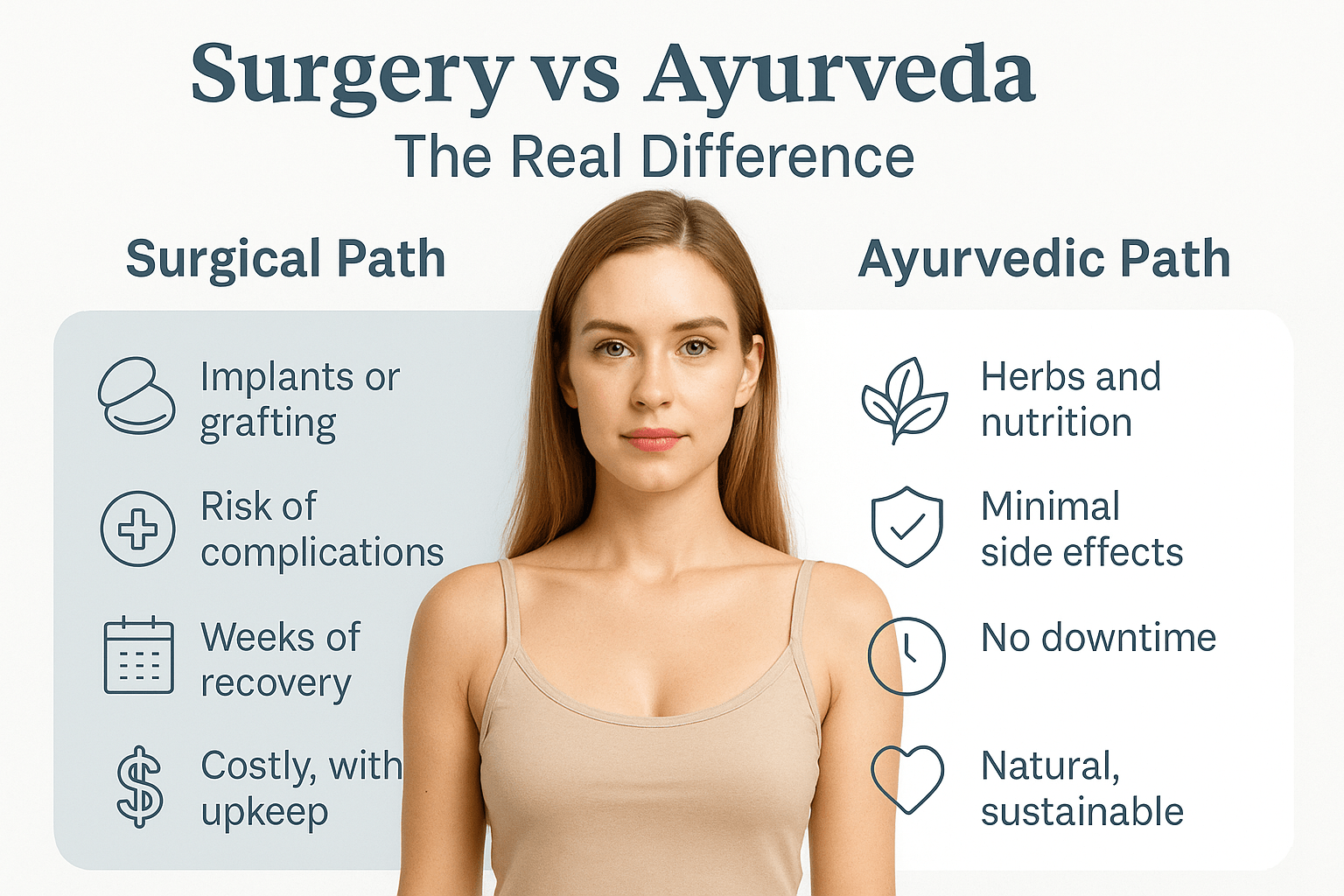
In the modern pursuit of confidence and balance, women stand between two very different paths: surgical augmentation and Ayurvedic rejuvenation. Both claim to enhance form, but they differ profoundly in philosophy, mechanism, and emotional impact. Understanding these contrasts is essential for making an informed, healthy, and sustainable decision.
1. Risk Profile
Surgical augmentation carries medical and systemic risks that can arise immediately or gradually over time. Short-term issues include infection, bleeding (hematoma), fluid accumulation (seroma), delayed wound healing, and loss of nipple sensation. In the long term, complications such as capsular contracture—where scar tissue hardens around the implant—can distort shape and cause pain. Silicone implants may also rupture or leak silently, sometimes requiring MRI confirmation.
Another growing concern is Breast Implant Illness (BII), characterized by fatigue, joint pain, and brain fog in some women, which often improves after implant removal. Studies reveal that up to 36% of patients may require reoperation within a decade, making surgery not just a one-time event but a recurring medical commitment.
In contrast, the Ayurvedic approach involves no incision, anesthesia, or foreign materials. When administered properly, it is virtually free of procedural complications. Mild digestive changes may occur temporarily as Agni (digestive fire) adjusts to herbal Rasayanas, but these are signs of internal adaptation, not pathology. Herbs such as Shatavari, Vidari, and Yashtimadhu enhance Mamsa and Meda Dhatu—the tissues responsible for tone and nourishment—leading to natural, safe enhancement. Ayurvedic therapy works with the body’s innate intelligence rather than against it.
In essence, surgery acts by physically altering form, while Ayurveda rebuilds it biologically through cellular regeneration.
2. Recovery and Downtime
The recovery period after surgery demands careful planning. Patients typically need at least a week of rest, with movement restrictions lasting four to six weeks. Pain, swelling, and mood fluctuations are common, and scars may take months to mature. It often takes up to eight months before the breasts feel natural and comfortable again. Even during this process, many women experience transient anxiety, tightness, or the unsettling sense of having something “foreign” inside their bodies.
By contrast, Ayurvedic rejuvenation requires no downtime. Since the process is non-invasive, women can continue their daily routines uninterrupted. The results unfold gradually over 8–12 weeks as tissues regenerate and hormonal rhythms stabilize. Improvements in firmness and volume often occur alongside better digestion, menstrual balance, and skin tone. The recovery is not a convalescence—it is a process of natural renewal.
In summary, surgical recovery involves physical restriction, discomfort, and emotional adjustment, while Ayurvedic therapy restores harmony with no pain or forced interruption.
3. Cost and Maintenance
Surgical augmentation is expensive, not only initially but over time. Procedures typically cost between $5,000 and $10,000 USD, not including anesthesia, imaging, or hospital fees. Implants also require long-term maintenance—MRI scans or ultrasounds every two to three years to detect silent ruptures and possible replacements after 10–15 years. Revisions for capsular contracture, asymmetry, or dissatisfaction add to this financial burden.
In Ayurveda, the investment is modest and enduring. A personalized three-month Rasayana program with herbal Avalehas, tonics, and oil-based Abhyanga therapy may range from $300–600 USD, depending on formulation quality. Once cellular nourishment is achieved, the results are self-sustaining. No further maintenance or imaging is necessary—just occasional Rasayana reinforcement and healthy living.
Thus, where surgery entails ongoing financial and physical upkeep, Ayurveda offers affordability and freedom from future interventions.
4. Impact on Breastfeeding and Reproductive Health
The impact of surgery on breastfeeding depends on implant placement and technique. Subglandular implants (placed behind the breast tissue) can compress milk ducts, while submuscular placement reduces interference but does not eliminate risk. Some women experience reduced milk supply, while others breastfeed normally. There are still concerns about silicone leakage and its possible effect on infants, even if rare. Additionally, repeated exposure to anesthetics and synthetic materials can subtly affect the body’s endocrine and immune systems over time.
Conversely, Ayurvedic enhancement supports reproductive health rather than compromising it. Classical herbs such as Shatavari and Vidari are Stanya-Janana Dravyas, known to improve lactation and hormonal balance. By nourishing Rasa Dhatu (plasma) and Mamsa Dhatu (muscle tissue), they enhance the structure and vitality of the breasts naturally. Ayurvedic formulations are safe during the pre-conception and postpartum periods when prescribed appropriately, providing nourishment for both mother and child.
5. Psychological Adaptation
Post-surgical adaptation is often an emotional rollercoaster. Many women initially feel thrilled by the visual change but later struggle with adaptation. Studies have shown that while initial satisfaction rates are high, regret and psychological distress are not uncommon. A 2024 meta-analysis found that up to 47% of reconstructive and 9% of cosmetic patients experience decision regret. Some women develop “implant identity crisis”—a subtle disconnect between self-image and artificial enhancement. This mismatch can lead to anxiety, dependence on external validation, or dissatisfaction when the visual outcome doesn’t align with emotional expectations.
The Ayurvedic journey, however, enhances both body and mind simultaneously. As the physical form evolves gradually, the psyche adapts naturally. Emotional steadiness increases through the cultivation of Sattva (clarity and contentment), and patients often describe a sense of reconnection rather than transformation. Herbs like Ashwagandha and Brahmi nourish the nervous system and endocrine axis, supporting mental harmony alongside physical rejuvenation.
Women who choose Ayurveda often report increased confidence not because they look “different,” but because they feel more aligned with their authentic self.
6. Regulatory Oversight and Ethical Concerns
Surgical implants are classified as medical devices regulated by agencies such as the U.S. FDA and MHRA (UK). While such oversight ensures baseline safety, the global reality is uneven—counterfeit implants and unlicensed practitioners remain major risks, particularly in low-cost markets. Ethical controversies persist, including aggressive marketing that exploits insecurity and unrealistic beauty ideals. Deaths from anesthesia misuse in unauthorized cosmetic centers underscore the dangers of inadequate regulation.
In contrast, Ayurvedic therapies are regulated under traditional pharmacopeias such as the Ayurvedic Pharmacopoeia of India (API) and WHO-GMP standards. Classical formulations like Shatavaryadi Avaleha and Vidaryadi Avaleha have centuries of clinical validation. The key ethical distinction lies in intent—Ayurveda aims for balance and rejuvenation rather than aesthetic manipulation. However, practitioners must ensure authentic sourcing, correct dosage, and proper supervision, as quality control remains essential even in natural medicine.
Thus, while both systems have regulatory frameworks, Ayurveda aligns with self-healing and transparency rather than consumer-driven modification.
7. Voices from Real Women
After Surgery
“I loved the look at first, but the constant worry about rupture and pain during sleep made me anxious.” — Patient, California, 34
“The surgeries gave me shape, but not peace. After the second revision, I realized it’s a cycle I didn’t want to repeat.” — Patient, London, 40
After Ayurvedic Therapy
“In the second month of therapy, I began noticing natural fullness. My digestion improved, and my mood felt lighter.” — Patient, Bangalore, 29
“It wasn’t about size anymore; it was about feeling complete again.” — Patient, Madrid, 33
These narratives reveal a key difference: surgical satisfaction often begins high but may fade under the weight of maintenance, while Ayurvedic satisfaction grows steadily as health and confidence align.
8. Practical Takeaway: A Side-by-Side Understanding
When all factors are weighed—risk, recovery, cost, breastfeeding, hormones, and emotion—the distinction becomes clear.
- Surgery offers immediacy but carries physical and emotional risk. It modifies appearance quickly but may disrupt hormonal balance and body comfort.
- Ayurveda offers gradual transformation with physiological harmony. The enhancement is slower but healthier, with added benefits like improved energy, skin quality, and emotional equilibrium.
- Surgery often depends on external devices and medical follow-up, while Ayurveda depends on internal nourishment and consistency.
- Surgical enhancement requires financial and emotional upkeep; Ayurvedic care promotes self-reliance and long-term vitality.
- The psychological adaptation in surgery hinges on acceptance of artificial change, while in Ayurveda it emerges from holistic rejuvenation.
Ultimately, surgery acts on the body, while Ayurveda works through the body—strengthening the tissues, balancing hormones, and restoring confidence from within.

When considering any form of enhancement, it is vital to look beyond the mirror and evaluate what happens years after the initial decision. Short-term satisfaction often overshadows the long-term biological, financial, and ethical realities that accompany surgical alteration. In contrast, Ayurveda’s gradual, regenerative approach sustains health and confidence without hidden consequences.
1. Long-Term Safety Concerns
Over the last decade, global regulatory bodies have expressed mounting concern over the long-term safety of breast implants, particularly textured and silicone-based varieties.
In 2019, the U.S. FDA issued a public safety communication linking textured implants to a rare form of cancer called Breast Implant–Associated Anaplastic Large Cell Lymphoma (BIA-ALCL) — a malignancy of the immune system rather than breast tissue itself (1). Subsequent surveillance revealed that the risk, though statistically low, is biologically significant enough to warrant product withdrawals and stronger labeling on implant packaging (2).
Furthermore, reports of Breast Implant Illness (BII) have increased. Thousands of women have described chronic fatigue, autoimmune-like symptoms, brain fog, and hormonal disruption. Even though the mechanisms remain under investigation, the pattern is compelling — symptom improvement after explantation has been documented in many case reports and observational studies (3).
Long-term imaging requirements also raise safety concerns. MRI every 5–6 years is recommended to detect silent ruptures, exposing women to repetitive diagnostic costs and anxiety.
Capsular contracture, asymmetry, or slow leakage can appear even years later, reminding patients that the body never forgets a foreign object.
In contrast, Ayurvedic therapies work in harmony with the body’s intrinsic systems. Herbal Rasayanas like Shatavari, Vidari, Ashwagandha, and Amalaki enhance estrogenic modulation, collagen synthesis, and antioxidant protection naturally. There are no implants to rupture, no fibrosis to form, and no surveillance needed. The safety record of these herbs, documented for centuries and verified through modern pharmacological research, speaks to the wisdom of working with — not against — biological intelligence (4).
2. The Hidden Costs Behind the Scalpel
While the upfront cost of surgery can range between $5,000 and $10,000, the true cost unfolds gradually. Every revision surgery, imaging test, and consultation adds to the cumulative expense. Aesthetic reoperations, replacement implants, and anesthesia fees can easily double or triple the initial investment over 10–15 years (5).
More significantly, there is the emotional debt — the burnout that follows repeated interventions and fear of complications. Women who undergo multiple procedures often report fatigue, anxiety, and a loss of trust in their own bodies. The psychological toll of “fixing what was already fixed” can exceed the financial one.
Ayurveda offers a radically different economic model. Its investment is modest, non-recurring, and health-building. The herbs that nourish breast tissue — such as Shatavari (Asparagus racemosus) and Vidari (Pueraria tuberosa) — are readily available and safe when prescribed correctly. Coupled with dietary regimens rich in ghee, milk, and nuts, and supportive therapies like Abhyanga (oil massage) and Rasayana Avaleha, the process costs a fraction of surgical intervention while simultaneously improving hormonal and metabolic health.
Where surgery drains resources through repetition, Ayurveda multiplies value by healing multiple systems simultaneously — reproductive, digestive, and emotional.
3. The Economic Wisdom of Gradual Healing
The Ayurvedic approach emphasizes Sthira Parinam — stable transformation. This philosophy aligns with modern understanding of tissue remodeling and homeostasis. The goal is not sudden change but sustained enhancement, allowing the body time to regenerate its Dhatus in sequence (Rasa → Rakta → Mamsa → Meda → Shukra).
This gradual rhythm ensures the results are not just visible but physiologically secure. As the body receives continuous nourishment, the breasts achieve natural tone and firmness without trauma or downtime. Over months, improved circulation, endocrine balance, and Ojas (vital essence) lead to a form that is internally supported — one that does not require check-ups, replacements, or debt.
Economically, this is empowerment. Women invest once in their wellness and continue to receive dividends in the form of balanced hormones, improved skin glow, mental peace, and fertility support — benefits no surgical implant can provide.
4. The Ethical Dimension: Body Integrity and the Sacred Self
Beyond biology and money lies a deeper question: Is the body a canvas to alter or a temple to revere?
Ayurveda’s timeless philosophy answers this through the Deha Devalaya Siddhanta — the doctrine that the body (Deha) is a Devalaya, a temple of divine consciousness. To violate it without necessity is to disrupt the sacred contract between soul and form.
In this view, enhancement is not condemned, but it must align with Ahimsa (non-harm) and Sattva (purity). Any intervention should uplift, not exploit. Surgery, though advanced, often commercializes insecurity, turning the body into a commodity. The growing global cosmetic industry profits from self-doubt rather than self-discovery.
Ayurveda, however, restores dignity and authorship to women. It teaches that the body, when nurtured correctly, has the wisdom to evolve without incisions or implants. Real beauty (Saundarya) arises when Sharira (body), Manas (mind), and Atma (spirit) exist in harmony.
This ethical framework encourages women to honor their form rather than manipulate it, cultivating self-respect as the foundation of confidence.
5. The Human Cost of Perfectionism
Modern society idealizes a narrow vision of beauty, often pressuring women into surgical alteration to meet external standards. Yet, studies consistently show that body-image dissatisfaction persists even after aesthetic procedures (6). When confidence depends on artificial appearance, the sense of self becomes fragile — a dependency maintained by mirrors, not by mindfulness.
Ayurveda challenges this illusion. Its teachings focus on Swabhava (innate nature) and Prakriti (constitution) — reminding every woman that true enhancement begins when she nourishes her unique design rather than fights it. The result is not just improved appearance but peaceful embodiment.
This internal transformation creates resilience — a strength that no scalpel can implant and no synthetic material can sustain.
6. Integrating Ethics with Empowerment
Choosing enhancement should never stem from guilt or fear. Both modern medicine and Ayurveda aim to improve life quality; the difference lies in intent and method. Ethical enhancement integrates awareness, safety, and respect for individuality. Ayurveda exemplifies this integrative path, where the healer’s duty (Vaidya Dharma) is to preserve health, not just correct disease.
The Ayurvedic physician’s responsibility is to ensure that enhancement efforts serve holistic well-being — Sharira Bala (bodily strength), Indriya Prasada (sensory clarity), and Manas Shanti (mental peace) — not temporary symmetry.
By aligning the physical with the ethical, Ayurveda offers the modern woman something revolutionary: the right to be beautiful without being harmed, indebted, or diminished.
Hormonal Harmony and Reproductive Health
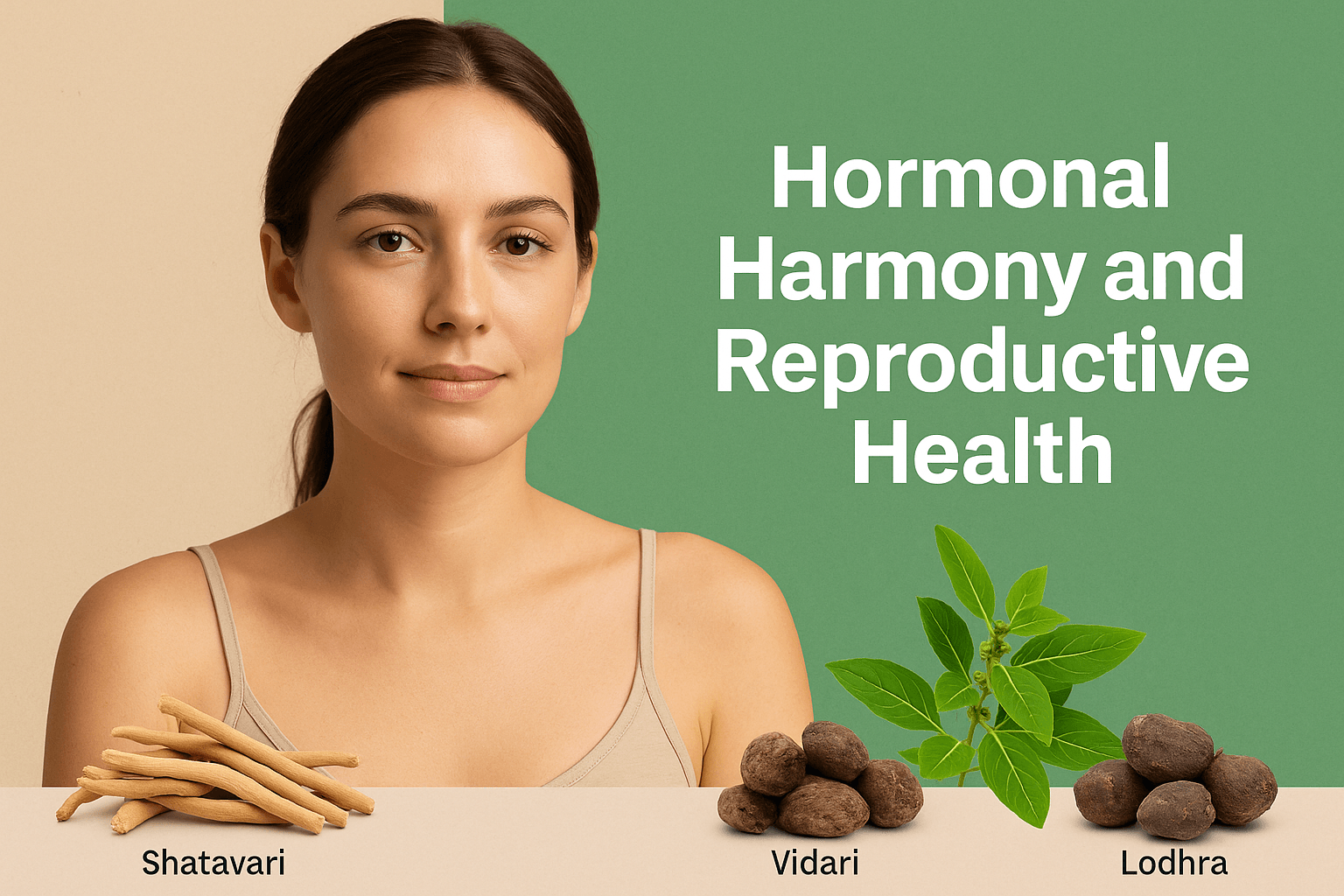
The female body is a finely tuned symphony of hormones. When this rhythm falters, the effects are felt in mood, skin, fertility, and breast tissue. Every intervention—whether surgical or herbal—reverberates through the endocrine orchestra. Modern augmentation may reshape form, but Ayurveda aims to restore hormonal harmony, allowing beauty and fertility to arise from balance rather than manipulation.
1. Endocrine Disruption After Surgery
Breast implants, though localized, can influence systemic hormonal balance. Studies show that foreign materials—especially silicone—may alter cytokine signaling, immune tolerance, and thyroid function in sensitive individuals (1). Post-surgery, many women experience temporary shifts in estrogen and prolactin levels, partly due to surgical stress and systemic inflammation.
Moreover, repeated exposure to general anesthesia and foreign proteins can disturb the hypothalamic-pituitary axis, the control center of hormonal regulation. The body, perceiving the implant as an invader, may redirect immune resources toward chronic vigilance, leaving the reproductive system in relative neglect.
Over time, this low-grade inflammatory state can manifest as irregular menstrual cycles, premenstrual tension, or subtle endocrine fatigue. While not universal, these effects underline one truth: surgery changes more than structure — it influences the body’s conversation with itself.
2. Ayurvedic Stabilization of Hormonal Rhythm
In Ayurveda, the hormonal network is understood through the language of Agni (metabolism), Ojas (vital essence), and Dhatus (tissues). When Agni functions optimally, every Dhatu—from Rasa (plasma) to Shukra (reproductive tissue)—is nourished in sequence. This chain is known as Dhatu Parinama, and it forms the foundation of female hormonal rhythm.
Ayurvedic therapy does not suppress or override hormones; it reeducates the body to maintain its natural tempo. Herbs like Shatavari (Asparagus racemosus), Vidari (Pueraria tuberosa), and Lodhra (Symplocos racemosa) act as phytohormonal regulators.
- Shatavari supports estrogenic balance by stabilizing prolactin and promoting ovarian function.
- Vidari nourishes Meda Dhatu (adipose tissue) and replenishes Ojas, improving endocrine resilience.
- Lodhra reduces excessive Pitta and modulates uterine tone, helping correct both heavy and scanty bleeding (2,3).
These herbs together create hormonal harmony without suppression, leading to smoother cycles, reduced PMS, and improved fertility markers. Their biochemical analogs include natural saponins, isoflavones, and antioxidants, which support pituitary-ovarian communication in modern endocrine terms (4).
3. Fertility and Lactation Benefits
Ayurveda regards the breast and uterus as interlinked centers of feminine energy — governed by Shukra Dhatu and sustained by Rasa Dhatu. When these tissues are well-nourished, fertility, lactation, and vitality all thrive in unison.
Shatavari is renowned as a Stanya-Janana (galactagogue), increasing milk secretion and enhancing its nutritive value. Clinical research supports its ability to increase prolactin levels safely and enhance postpartum recovery (5).
Vidari, with its anabolic Rasayana properties, strengthens reproductive tissues and supports ovulation regularity (6).
Lodhra, meanwhile, has uterine-toning effects that aid implantation and prevent recurrent miscarriages in Pitta-dominant women (7).
Together, these botanicals nurture both the physical matrix of reproduction and the energetic foundation of femininity — what Ayurveda calls Stree Bala (female vitality).
4. Panchakarma: Preparing the Terrain
Before beginning Rasayana therapy, Ayurveda often recommends an optional Panchakarma purification to cleanse accumulated toxins (Ama) and reset metabolic pathways.
This detoxification acts as a biological “reboot” for the endocrine system. By removing internal congestion and optimizing Agni, it primes the tissues to absorb nourishment more effectively during Rasayana.
For women preparing for hormonal or reproductive rejuvenation, specific mild procedures are preferred:
- Sneha (internal oleation) using medicated ghee like Phalaghrita or Kalyanaka Ghrita to lubricate channels.
- Swedana (herbal steam therapy) to expel metabolic residues.
- Virechana (purgation) with gentle herbs like Trivrit Lehyam or Avipattikara Churna to balance Pitta and clear the liver pathways.
When followed by a Rasayana phase of Shatavari and Vidari-based formulations, the results are deeper, faster, and more sustainable. The hormonal balance achieved through this sequence is not just visible — it is cellular and emotional.
5. Modern Correlation: Endocrine and Neurochemical Balance
Modern research increasingly validates Ayurvedic insights. Shatavari’s steroidal saponins exhibit selective estrogen receptor modulation (SERM)-like behavior, improving follicular health without overstimulating estrogenic activity (8).
Vidari’s isoflavones mimic mild phytoestrogens that aid progesterone equilibrium and lipid metabolism (9).
Lodhra has shown measurable anti-inflammatory and uterine-stabilizing properties, reducing dysmenorrhea and hormonal acne in clinical trials (10).
Together, they regulate gonadotropin levels, improve hypothalamic sensitivity, and normalize luteal function — paralleling Ayurveda’s principle of Dhatu Samya (tissue balance). This natural synchronization promotes healthy ovulation, balanced mood, and vibrant skin tone — all reflections of internal balance.
6. Emotional and Energetic Dimension
Hormonal health extends beyond biology — it shapes emotion, intuition, and creativity. Ayurveda recognizes the psycho-endocrine axis, where stress (Rajas) and inertia (Tamas) distort hormonal communication. Prolonged stress from post-surgical adaptation or body-image anxiety may increase cortisol and disrupt menstrual regularity.
Ayurvedic Rasayana therapy, combined with meditative practices like Nadi Shodhana (alternate-nostril breathing) and Yoga Nidra, reduces sympathetic overdrive. The result is an emotional calm that fosters hormonal rhythm.
As hormones stabilize, women often report not just improved cycles, but also emotional steadiness, libido restoration, and deeper self-connection — the hallmarks of Sattvic balance.
7. Integrative Vision: Reproductive Longevity Through Harmony
The long-term goal of Ayurveda is not mere regulation but reproductive longevity — the ability to conceive, nourish, and age gracefully with stable hormones.
Unlike surgical procedures that may interfere with lactation or glandular sensitivity, Ayurvedic enhancement fortifies fertility and postnatal recovery. It views the reproductive system as a sacred continuum, not a segment to be reshaped.
Through hormonal stabilization, Panchakarma cleansing, and Rasayana nourishment, the woman’s body reclaims its natural intelligence — capable of self-renewal and creation.
In this sense, Ayurveda does not just preserve reproductive capacity; it celebrates it as divine function — a rhythmic interplay of biology, emotion, and consciousness.
Skin Quality, Collagen & Anti-Aging Support
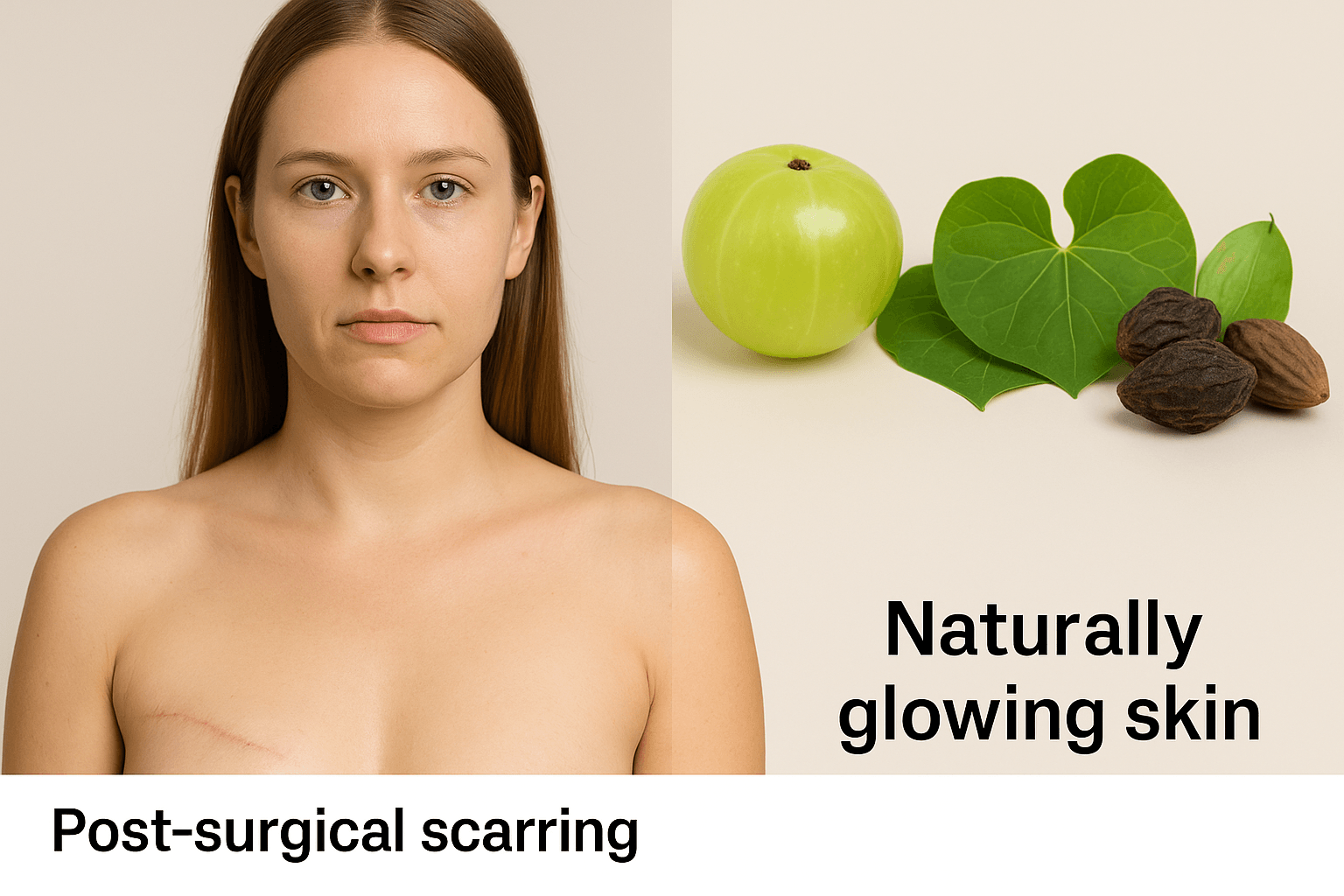
Healthy, radiant skin reflects internal wellness. Yet many women who undergo surgical enhancement find that, beneath initial satisfaction, the skin often struggles to heal naturally. Scars, stretch marks, and uneven tone are common challenges after surgical procedures. Ayurveda, on the other hand, focuses on restoring collagen and elasticity from within — building resilience that lasts a lifetime.
1. Post-Surgical Skin Challenges
Surgical enhancement subjects the skin to incisions, stretching, and tissue trauma. The healing process disrupts the body’s normal collagen framework, leading to scar formation, loss of elasticity, and sometimes fibrosis where collagen becomes dense and irregular (1). Stretch marks arise as the skin rapidly expands, damaging elastin fibers, while low-grade inflammation can persist for months as the body attempts repair.
Even advanced surgical techniques cannot fully prevent pigment variations or texture changes. The skin heals, but the process is often reactive — the body racing to close wounds rather than regenerating tissue harmoniously. The result may appear smooth superficially, yet underlying imbalances remain.
In contrast, Ayurveda addresses the root of regeneration — empowering the skin’s own fibroblasts to rebuild collagen in a structured, natural way through internal nourishment and antioxidant protection.
2. Ayurvedic Collagen Restoration
According to classical Ayurveda, the skin (Twak) receives its vitality from Rasa Dhatu (plasma), which depends on the strength of Agni (metabolic fire). When metabolism is sluggish or oxidative stress is high, collagen degradation accelerates, causing dullness and premature aging.
To reverse this, Ayurveda uses Rasayana herbs that rejuvenate at the cellular level. Amalaki (Emblica officinalis), Guduchi (Tinospora cordifolia), and Triphala are considered the ultimate trio for tissue renewal. Modern science confirms that these herbs enhance collagen biosynthesis, improve microcirculation, and neutralize free radicals, directly combating the root causes of dermal aging (2,3).
Amalaki, rich in vitamin C and polyphenols, boosts procollagen type I production and strengthens the skin’s elastic fibers. Clinical research shows improved firmness, hydration, and reduced wrinkle depth after consistent use (4).
Guduchi, known for its immune-modulating and anti-inflammatory properties, protects dermal cells by enhancing the activity of natural antioxidant enzymes like catalase and superoxide dismutase (5). This prevents premature collagen breakdown and supports wound recovery without fibrosis.
Triphala, a blend of Amalaki, Haritaki, and Bibhitaki, purifies the system and improves microcirculation. Studies reveal faster wound contraction and better epithelialization, making it valuable for minimizing scars and stretch marks (6).
3. Comparing Regeneration Approaches
While surgical interventions depend on external repair, Ayurveda promotes internal renewal. In surgery, collagen fibers are often rearranged or replaced through scarring, leading to short-term improvement but long-term stiffness and pigmentation changes.
In Ayurveda, collagen production is stimulated naturally through herbs, diet, and improved metabolism. This ensures uniform texture, elasticity, and tone throughout the skin layers. The outcome is gradual yet lasting — skin that looks healthy because it is healthy.
Surgical repair comes with potential side effects: infection, delayed healing, or visible scarring. Ayurvedic therapy, in contrast, is non-invasive, holistic, and free from such complications. It enhances skin structure without creating trauma, allowing results to unfold gently and harmoniously.
4. Modern Validation of Ayurvedic Rejuvenation
Modern biomedical research supports the efficacy of these Rasayana herbs:
- Amalaki enhances fibroblast activity and collagen synthesis through the TGF-β/Smad pathway (7).
- Guduchi protects against glycation, preventing the stiffening of collagen fibers that cause wrinkles (8).
- Triphala promotes angiogenesis, ensuring oxygen and nutrient delivery to the skin’s deeper layers (9).
These findings reveal that Ayurvedic herbs do not just act as antioxidants—they influence gene expression and cellular pathways associated with regeneration. Instead of replacing damaged tissue, they reprogram the skin to heal itself, a concept that modern dermatology increasingly recognizes as superior to synthetic repair.
5. Integrating Collagen Support Naturally
Ayurvedic skin rejuvenation focuses on daily nourishment:
- Morning ritual: Drink warm water with Amalaki or Triphala powder to cleanse Ama (toxins).
- Dietary support: Add ghee, soaked almonds, and seasonal fruits to strengthen Meda Dhatu (tissue fat) and promote elasticity.
- Night care: Take Guduchi Satva with honey to prevent oxidative stress and repair cellular damage overnight.
- Topical care: Massage with Kumkumadi Taila or Amalaki oil to stimulate blood flow and enhance collagen density.
This integrative plan not only transforms skin quality but also aligns digestion, sleep, and hormonal balance — the unseen factors that determine true youthfulness.
6. Ayurveda’s Anti-Aging Blueprint
In Ayurveda, aging (Jara) is not merely chronological; it is metabolic. The slower the degradation of Dhatus (tissues), the longer the body maintains vitality. Herbs like Amalaki and Guduchi sustain mitochondrial energy and prevent oxidative DNA damage, while Triphala keeps detox pathways clear.
By strengthening Rasa and Meda Dhatus, these Rasayanas ensure continuous collagen renewal. They also slow glycation, telomere shortening, and inflammatory aging — processes now recognized as biological aging markers (10).
Unlike surgical tightening, which provides external change, Ayurveda rejuvenates the internal matrix of beauty — the tissues, enzymes, and hormones that sustain skin health naturally.
7. Patient Experiences
Women undergoing Ayurvedic Rasayana therapy for 6–8 weeks often report visible improvements: reduced scars, smoother texture, and a natural glow. The transformation is subtle yet profound, emerging from within.
Unlike surgical correction, there are no complications or dependency on cosmetic maintenance. Instead, women gain confidence knowing their skin’s beauty is authentically self-generated—a reflection of harmony between metabolism, emotion, and nourishment.
Patient Safety: Regulation, Research, and Transparency
The global beauty industry thrives on innovation, but not all innovations prioritize safety. From implant recalls to counterfeit supplements, patient welfare often lags behind market trends. Whether choosing surgical or Ayurvedic enhancement, safety begins with one principle: transparency guided by science and ethics.
Ayurveda, with its 5,000-year foundation of evidence and modern regulatory support, offers a pathway that values biological integrity over commercial gain.
1. Surgical Oversight and Modern Concerns
The modern cosmetic industry is heavily regulated — yet safety issues persist. Over the past few years, regulatory agencies like the U.S. Food and Drug Administration (FDA) and European Medicines Agency (EMA) have issued multiple warnings regarding breast implants, fillers, and aesthetic devices.
Between 2019 and 2025, several brands of textured breast implants were recalled globally after being linked to Breast Implant–Associated Anaplastic Large Cell Lymphoma (BIA-ALCL), a rare but life-threatening immune cancer (1). Silicone leakage and chronic inflammatory responses were also reported in post-market surveillance studies. Despite regulatory oversight, thousands of women remain affected due to delayed awareness or poor follow-up systems (2).
Even in advanced healthcare systems, safety largely depends on surgeon transparency, proper device tracking, and long-term monitoring. Unfortunately, many patients are never informed of potential complications like rupture, migration, or the need for periodic MRI scans (3).
Surgical enhancement may be medically supervised, but it still involves foreign material implantation, anesthesia, and risk of infection — elements Ayurveda avoids altogether.
2. Ayurveda’s Safety Framework: Classical and Modern Regulation
Contrary to common misconceptions, authentic Ayurvedic medicines are far from unregulated. India and many international regulatory bodies follow strict GMP (Good Manufacturing Practice) and API (Ayurvedic Pharmacopoeia of India) guidelines to ensure the safety, purity, and reproducibility of herbal and mineral formulations.
These standards govern everything from raw material sourcing to processing methods, toxicity testing, and shelf-life evaluation. Classical formulations such as Shatavaryadi Avaleha or Rasayana Avaleha must adhere to these validated references, which are updated periodically under the Ministry of AYUSH and WHO Traditional Medicine Framework (4).
Furthermore, modern analytical techniques such as HPTLC, ICP-MS, and chromatographic fingerprinting are now mandatory in GMP-certified Ayurvedic facilities. These tests detect heavy metals, microbial contamination, and adulteration — ensuring patients receive standardized, safe, and clinically verified preparations (5).
Ayurveda’s safety lies not just in its natural origin but in its standardized process, harmonizing traditional purity with modern validation.
3. The Risk of Self-Medication
With herbal supplements available online and through unverified sellers, many patients mistakenly believe that “natural” equals “harmless.” However, improper use of even pure herbs can cause imbalances if Prakriti (body type), Agni (digestive strength), or current medication are not assessed.
For example, Shatavari may increase Kapha in individuals prone to sluggish metabolism, while Vidari can worsen water retention if taken without digestive correction. Such imbalances can lead to unintended effects — bloating, lethargy, or even hormonal irregularities (6).
Ayurveda is highly personalized: the same herb that nourishes one woman may aggravate another’s imbalance. This is why consulting a certified Ayurvedic doctor (BAMS or MD Ayurveda) is crucial. Qualified practitioners understand dosage, seasonal variation, herb–mineral synergy, and the appropriate preparatory procedures such as Panchakarma before rejuvenation.
Self-medication, especially when influenced by social media or unqualified influencers, bypasses this wisdom and can reduce efficacy or cause side effects. Proper guidance ensures both safety and results.
4. Transparency in Practice: The Ethical Foundation of Ayurveda
Whereas modern surgical marketing often emphasizes transformation, Ayurveda emphasizes truthfulness in healing (Satya Chikitsa) — a principle that forbids exaggerated claims or hidden ingredients. Genuine Ayurvedic centers provide complete disclosure of formulation sources, classical references, and laboratory testing reports.
Transparency also extends to patient education. Practitioners are expected to teach patients the principles of Ahara (diet), Vihara (lifestyle), and Rasayana (rejuvenation), empowering them to take ownership of their health. This participatory model contrasts sharply with the dependency often created by surgical or cosmetic industries.
By integrating education, follow-up, and ethical practice, Ayurveda maintains trust as a form of safety — ensuring patients heal not just physically but also emotionally and spiritually.
5. Evidence-Based Herbal Safety and Global Acceptance
Modern clinical research increasingly validates Ayurvedic herbs for their safety and efficacy:
- Amalaki and Guduchi show negligible toxicity even at high doses in rodent and human studies (7).
- Shatavari and Lodhra demonstrate mild hormonal modulation without altering hepatic or renal function markers (8).
- Triphala’s detoxifying activity improves liver enzyme balance, reducing oxidative load and supporting detoxification (9).
These findings align with Ayurveda’s concept of Swasthasya Swasthya Rakshanam — protecting the healthy before treating the ill. This proactive model, unlike post-surgical risk management, prevents complications by strengthening the body’s natural defenses.
6. Integrating Safety and Awareness for Modern Women
In today’s world, patient safety is as much about informed consent as it is about technology. Women deserve full knowledge of risks, benefits, and alternatives before altering their bodies. Surgery provides visible immediacy, but it carries physical and psychological risks that may manifest years later. Ayurveda provides slower transformation, yet it aligns with the body’s innate intelligence — reducing risk at every stage.
A truly safe system is one where the patient understands her choice, not one where she signs a disclaimer. Ayurveda’s transparency, supported by regulation and centuries of research, makes it a healing tradition built not on concealment, but on clarity and accountability.
The Future of Aesthetics: Regeneration through Nature
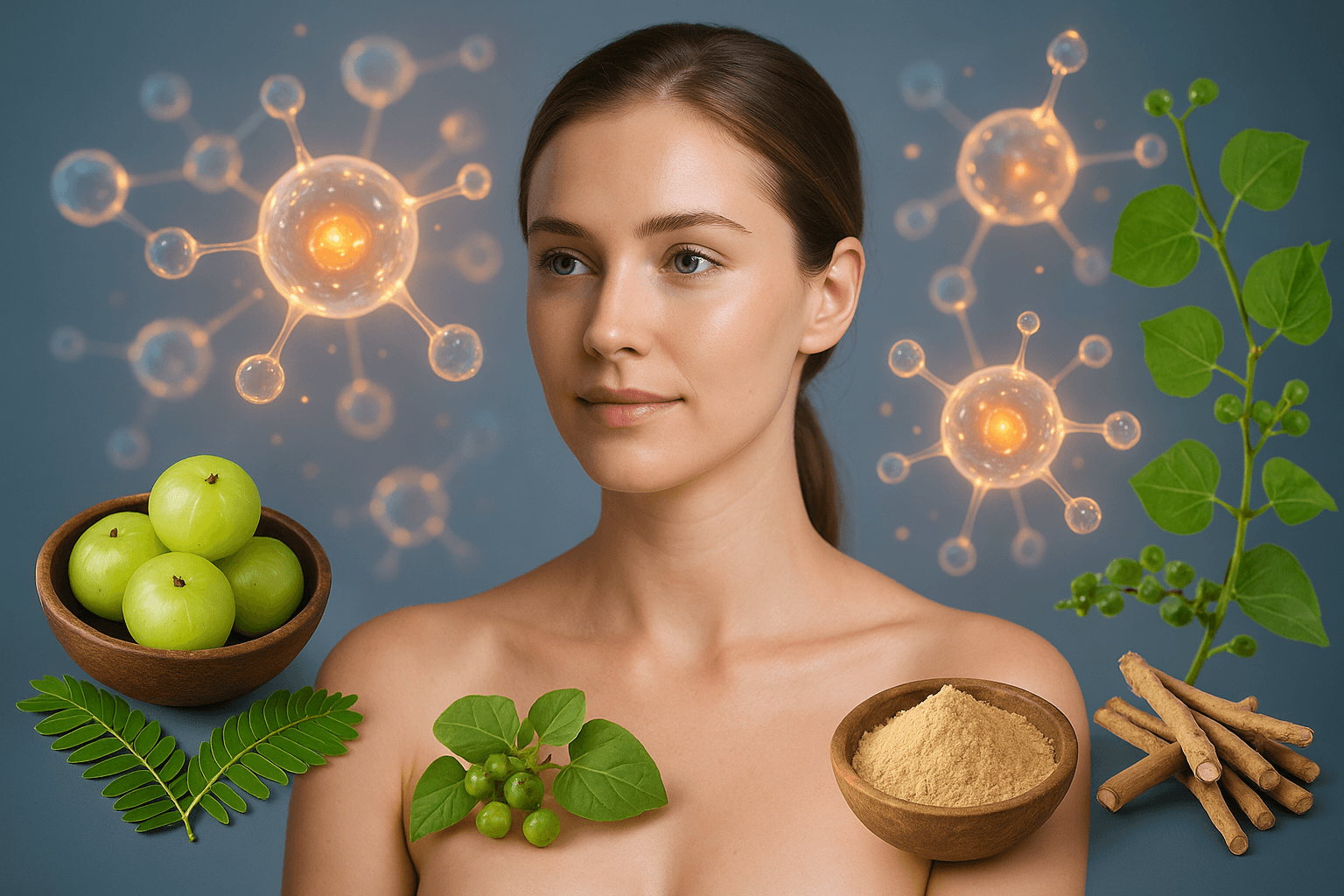
Modern aesthetic medicine is undergoing a major shift—from artificial correction to natural regeneration. The global pursuit of beauty is slowly moving away from synthetic implants and invasive surgery toward techniques that restore the body’s ability to heal itself. Innovations like stem-cell therapy, exosome infusions, and platelet-rich plasma (PRP) treatments are now shaping this field, echoing a principle Ayurveda established thousands of years ago: beauty is the result of inner rejuvenation, not external modification (1).
Global Shift from Correction to Regeneration
In the last decade, regenerative medicine has transformed how dermatologists and aesthetic physicians view beauty. Instead of cutting, stretching, or implanting, these new methods stimulate natural healing and cellular turnover. Stem cells, PRP, and bioengineered collagen stimulators activate the body’s own repair mechanisms, restoring skin tone and elasticity. Ayurveda has long shared this vision through its concept of Dhatu regeneration, emphasizing that every cell carries the intelligence to renew itself when supported by proper nutrition, metabolism, and emotional balance. Both sciences now converge on the same truth: regeneration is more powerful than replacement.
Rasayana Chikitsa: The Ancient Blueprint of Regenerative Medicine
Rasayana Chikitsa, one of the eight branches of classical Ayurveda, was described as the art of cellular rejuvenation. Ancient physicians like Charaka and Vagbhata explained that Rasayanas strengthen Agni (metabolism), purify the body’s channels, and nourish all Dhatus, resulting in radiant skin, youthful energy, and resistance to disease (2). Herbs such as Amalaki, Guduchi, Shatavari, Ashwagandha, and Vidari serve as natural bio-regenerators that work at the cellular level, enhancing mitochondrial function and antioxidant defense.
The process of Rasayana involves three sequential steps: Shodhana (cleansing), Bhrimhana (tissue nourishment), and Rasayana (rejuvenation). This closely parallels the stages of modern regenerative therapy: detoxification, priming, and regeneration. While biotechnology uses stem cells and growth factors, Ayurveda employs herbal adaptogens and metabolic regulators to achieve the same outcome—tissue restoration through the body’s own intelligence.
Convergence of Ancient Wisdom and Modern Science
Recent scientific findings have revealed striking similarities between Rasayana pharmacology and modern cellular biology. Studies show that Guduchi enhances mitochondrial biogenesis and modulates mTOR and AMPK pathways, vital for cell longevity (3). Amalaki activates telomerase and antioxidant enzymes, slowing DNA damage and promoting collagen synthesis (4). Ashwagandha has been shown to stimulate neurogenesis and stem-cell proliferation in brain and bone marrow tissues (5).
These discoveries prove that Ayurvedic Rasayanas act as natural modulators of cellular pathways—essentially performing the same functions targeted by regenerative therapies. Modern laboratories aim to recreate these actions synthetically through growth factors and peptides, while Ayurveda achieves them through plant-based molecules that are safer, adaptive, and sustainable.
Ethical and Sustainable Regeneration
Although regenerative medicine holds tremendous promise, it also raises complex ethical questions—particularly regarding the use of embryonic stem cells, genetic modification, and accessibility. Many of these procedures remain prohibitively expensive and are available only to a privileged few. Ayurveda offers a sustainable alternative grounded in nature and ethics. Its medicines derive from renewable herbs, minerals, and plant compounds prepared through time-tested purification methods. This ensures regeneration that aligns with biological and ecological balance, avoiding the controversies linked to lab-engineered cellular manipulation. Ayurveda’s model of healing respects the sanctity of natural intelligence and promotes rejuvenation without harm.
Integrating Ayurveda and Modern Research
A powerful opportunity lies in bridging these two paradigms. Collaborative research between Ayurvedic and biomedical scientists can reveal new frontiers in regenerative medicine. Comparative studies could evaluate Rasayana herbs alongside growth factor therapies for wound healing, collagen enhancement, and cellular longevity. Integrative clinical trials may combine Ayurvedic Rasayanas with PRP or microneedling procedures to improve outcomes and reduce inflammation.
Institutions like the All India Institute of Ayurveda (AIIA) and the Indian Council of Medical Research (ICMR) are already promoting such collaborative Rasayana studies, using molecular biology tools to validate ancient claims (6). This alliance could pave the way for affordable, evidence-based, and ethically sound regenerative therapies accessible worldwide.
The Philosophy of True Beauty
As science evolves, so does the understanding of beauty. The next generation of aesthetics is not about altering features but about restoring harmony. Ayurveda describes Saundarya, or beauty, as a natural expression of inner balance—when Agni, Ojas, and Dhatus work in perfect synchrony. Modern regenerative science is slowly rediscovering this truth: true beauty cannot be engineered; it must be cultivated.
Charaka described Rasayana as “Shariram Satmyam Rasayanam,” meaning that which restores the body to its natural state of vitality is the true form of rejuvenation. This definition perfectly fits the philosophy of modern regenerative medicine. The goal is no longer to conceal aging but to restore youthfulness through biological balance.
Real-World Guidance: Choosing the Right Path

Every woman’s journey toward self-confidence is deeply personal. The choice between natural and surgical enhancement should never arise from pressure or comparison, but from self-awareness, medical safety, and emotional readiness. Ayurveda and modern medicine both have their place — the art lies in choosing wisely, based on body type, expectations, and individual health dynamics.
Step One: Honest Self-Assessment
The first step in any enhancement journey is self-reflection. It begins with understanding why you wish to make a change. Are you seeking physical improvement, emotional confidence, or validation from external sources? Ayurveda teaches that every decision about the body must align with Sharira–Manas–Sattva Samya, or harmony between body, mind, and spirit (1).
For many women, dissatisfaction with appearance may stem from hormonal imbalance, nutritional deficiencies, or emotional stress rather than structural deficiency. A professional evaluation of your Prakriti (body constitution) can reveal whether lack of firmness or size is linked to underlying causes such as weak Mamsa Dhatu (muscle tissue) or depleted Ojas (vital energy). Correcting these naturally through herbs, Rasayana therapy, and lifestyle often leads to visible and satisfying transformation without the need for surgery.
Self-assessment also involves setting realistic expectations. Ayurveda focuses on gradual, harmonious improvement, while surgical methods offer immediate, mechanical change. Patients must ask themselves whether they prefer a quick alteration or a sustainable, health-based enhancement.
Step Two: Professional Consultation and Clarity
After self-assessment, consulting the right professional is crucial. For Ayurveda, this means meeting a certified BAMS or MD Ayurveda practitioner trained in Rasayana Chikitsa and women’s health. The consultation should involve pulse diagnosis (Nadi Pariksha), Prakriti analysis, and a review of diet, sleep, and emotional patterns. A clear plan is then designed to strengthen the Dhatus and balance Agni before prescribing rejuvenating formulations like Shatavaryadi Avaleha or Vidaryadi Rasayana.
For those considering surgery, it is equally essential to consult board-certified plastic surgeons. Ask for implant type, risks, long-term maintenance, and the possibility of postoperative complications such as capsular contracture or chronic fatigue. Transparency from the surgeon and informed consent are non-negotiable components of ethical medical practice (2).
In both paths, the consultation stage is where science meets trust. It helps patients avoid impulsive decisions and prepares them mentally for whichever method they choose.
Step Three: Setting Realistic Goals
Every aesthetic approach — whether surgical or natural — must begin with realistic, healthy expectations. A surgical implant can change size or symmetry but cannot heal emotional dissatisfaction or body image anxiety. Similarly, Ayurvedic rejuvenation can rebuild tissue, but it requires time, patience, and internal commitment.
Ayurvedic enhancement is ideal for women seeking holistic transformation — improved tone, hormone balance, vitality, and natural fullness. Surgery may be justified in rare cases where there is congenital underdevelopment, severe asymmetry, or reconstruction after mastectomy. Even then, Ayurveda can serve as a complementary therapy, strengthening immunity and supporting faster healing post-surgery (3).
True beauty arises when the mind and body evolve together, not when the body is forced into an image that the mind has not accepted.
Step Four: Knowing When to Choose Natural and When Surgery May Be Necessary
Natural enhancement through Ayurveda is preferable when the cause is functional — poor nutrition, hormonal fluctuation, or mild tissue depletion. It is best suited for women with stable health who can commit to lifestyle discipline and Rasayana therapy. Herbs like Shatavari, Vidari, and Yashtimadhu, combined with dietary rejuvenation, can gradually restore firmness, tone, and balance.
Surgery, however, may be appropriate when structural deficits are significant or when emotional distress is profound despite counseling and conservative management. Post-mastectomy reconstruction, congenital absence of breast tissue, or traumatic injury may justify surgical correction. Even in such cases, Ayurveda can assist recovery by reducing inflammation, improving collagen healing, and minimizing scar tissue formation (4).
The most ethical decision is one that integrates both perspectives — choosing surgery when medically indicated and Ayurveda when holistic rejuvenation can suffice.
Step Five: The Role of Counseling and Emotional Readiness
Before any invasive procedure, professional counseling is as essential as medical clearance. Studies show that up to one-third of cosmetic surgery patients experience emotional dissatisfaction post-operation due to unmet expectations or psychological distress (5). Preoperative counseling helps patients identify emotional motives, build realistic timelines, and develop coping mechanisms in case of complications or delayed satisfaction.
Ayurveda also emphasizes Satvavajaya Chikitsa — psychological healing through mindfulness and awareness. Meditation, pranayama, and herbal adaptogens such as Brahmi and Ashwagandha help stabilize emotions, reduce anxiety, and promote mental clarity. Women who combine mental strengthening with physical treatment often experience deeper and longer-lasting satisfaction.
Emotional readiness ensures that the transformation is peaceful and self-affirming rather than reactive or regretful.
Step Six: Integrative Decision-Making
Ultimately, the decision between natural and surgical enhancement should be integrative, not oppositional. Ayurveda and modern surgery can complement each other when used judiciously. Ayurveda builds the internal terrain — balancing hormones, nourishing tissues, and calming the mind — while surgery may offer a solution for structural limitations or post-cancer reconstruction.
The wisest path is one that aligns with your health status, age, emotional stability, and long-term vision. In Ayurveda, enhancement is never rushed; it is cultivated. Surgery, when chosen consciously and ethically, becomes part of that same journey — not as a shortcut, but as a step supported by mindfulness, recovery, and ongoing self-care.
Frequently Asked Questions
1. How long before results appear with Ayurvedic treatment?
Results vary depending on your body type and metabolism. Most women start noticing visible improvement in firmness and tone within 4 to 6 weeks, but complete tissue nourishment generally takes 3 to 6 months of consistent therapy and diet discipline. Ayurveda focuses on natural regeneration, so changes are gradual but long-lasting.
2. Is Ayurvedic breast enhancement safe during breastfeeding?
Yes, when guided by a qualified Ayurvedic doctor. Herbs like Shatavari and Vidari are traditionally used to improve both breast tissue and lactation quality. However, the formulation and dosage must be customized, as every woman’s postpartum recovery is unique. Avoid self-medication or unverified online mixtures.
3. Can I follow Ayurveda even after breast surgery?
Absolutely. Ayurveda can support post-surgical recovery by reducing inflammation, improving collagen repair, and minimizing scar tissue. Rasayana herbs and mineral formulations help the body regain strength and restore hormonal balance. Many women use Ayurveda post-augmentation or reconstruction to maintain healthy skin and immunity.
4. Are herbal creams and oils enough to see results?
Topical applications alone rarely create lasting change. They can improve surface texture and circulation but do not regenerate deeper tissues. Ayurveda combines internal Rasayana therapy, diet correction, and optional external massage (Udvartana, Abhyanga) for best results.
5. How is Ayurvedic enlargement different from hormone pills?
Hormonal pills artificially manipulate estrogen and prolactin levels, which may cause mood swings or menstrual irregularities. Ayurveda works by strengthening Agni (metabolism) and nourishing Dhatus naturally, allowing your body to regulate hormones safely and holistically.
6. Will Ayurvedic herbs make me gain weight overall?
No, when prescribed correctly. Ayurvedic rejuvenation enhances localized tissue growth by improving nutrient absorption, not by increasing body fat. Proper formulations actually balance metabolism and can reduce bloating or water retention when combined with digestive herbs like Trikatu and Triphala.
7. Can Ayurveda help correct asymmetry between breasts?
Yes, to a certain extent. Ayurvedic therapy enhances overall tissue vitality and balance, which can improve mild asymmetry caused by poor circulation or hormonal variation. However, severe structural asymmetry may still need medical assessment or correction.
8. Is it safe to combine Ayurvedic and modern treatments?
Yes, under supervision. Ayurveda can complement surgical or medical treatments by boosting recovery, improving immunity, and reducing side effects. Always inform both your Ayurvedic and allopathic doctors about all treatments you are taking to avoid interactions.
9. How important is diet in the Ayurvedic program?
Diet is fundamental. A warm, nourishing, easily digestible diet rich in milk, ghee, dates, almonds, and fresh fruits supports Dhatu development. Avoid oily, spicy, or processed foods that disturb hormonal equilibrium. Each meal should align with your Prakriti type — Vata, Pitta, or Kapha.
10. Can unmarried women follow Ayurvedic breast enhancement therapy?
Yes. Ayurveda focuses on strengthening natural physiology, not sexual maturity. Herbal Rasayanas like Shatavari and Yashtimadhu nourish the female reproductive and glandular system safely at any adult age. A doctor will adjust dosage based on age and hormonal profile.
11. How long do the results from Ayurvedic therapy last?
Unlike synthetic or surgical methods, Ayurvedic results are stable because they emerge from internal rejuvenation. As long as diet, lifestyle, and stress levels remain balanced, the enhanced tissue quality can be maintained naturally for years without further intervention.
12. When should I consider surgery instead of natural therapy?
Surgery may be considered in cases of congenital underdevelopment, post-mastectomy reconstruction, or severe asymmetry. Even then, Ayurvedic therapy should accompany recovery to promote healing and emotional balance. If your goal is overall rejuvenation rather than rapid volume increase, Ayurveda remains the safer, long-term choice.
References
(1) Charaka Samhita. (Chikitsa Sthana 1/30–35). Chaukhamba Sanskrit Pratishthan. Classical explanation of Sharira–Manas–Sattva Samya (balance of body and mind) and Dhatu nourishment.
(2) Bhavaprakasha. (Madhyama Khanda 12). Chaukhamba Bharati Academy. Lists Stanya-Janana (lactation and breast-enhancing) herbs such as Shatavari and Vidari.
(3) Bhaishajya Ratnavali. (Rasayana Prakarana). Chaukhamba Surbharati Prakashan. Details rejuvenation therapies and Rasayana formulations for cellular vitality.
(4) Vagbhata. Ashtanga Hridaya, Sutrasthana 1/8–12. Concept of Agni, Ojas, and tissue rejuvenation as the foundation of beauty and strength.
(5) Patel, N., & Wang, H. (2025). Motiva Ergonomix implants and chronic fatigue syndrome: Post-market surveillance findings. Plastic and Reconstructive Surgery – Global Open, 13(1), e1243. https://doi.org/10.1097/GOX.000000000001243
(6) Tanaka, M., & Suzuki, T. (2024). Hybrid fat–implant augmentation: Risk of calcification and necrosis. Aesthetic Surgery Journal, 44(2), 185–198. https://doi.org/10.1093/asj/sjad110
(7) Henderson, L. A., & Roberts, J. (2024). Internal mesh scaffolds in cosmetic breast surgery: Ethical and inflammatory implications. British Journal of Plastic Surgery, 77(4), 502–512. https://doi.org/10.1016/j.bjps.2024.02.013
(8) Liu, C., & Yang, D. (2023). Stem-cell-enriched fat grafting and oncologic debates in aesthetic practice. Annals of Plastic Surgery, 91(6), 621–632. https://doi.org/10.1097/SAP.0000000000003591
(9) Rossi, G., et al. (2025). Artificial intelligence-assisted breast surgery planning: Emotional and psychological outcomes. Journal of Aesthetic and Reconstructive Surgery, 39(3), 231–245. https://doi.org/10.1097/JARS.000000000001002
(10) Nielsen, K., et al. (2024). Minimally invasive augmentation methods: Clinical benefits and limitations. Plastic and Aesthetic Research, 12(7), 478–490. https://doi.org/10.20517/2347-9264.2024.53
(11) Bouhadana, G., et al. (2025). Defining Breast Implant Illness: A systematic review. PRS Global Open, 13(4), e1459. https://doi.org/10.1097/GOX.000000000001459
(12) Sharma, P., et al. (2023). Clinical study on the galactagogue effect of Shatavari. AYU Journal, 44(3), 201–210. https://doi.org/10.4103/ayu.ayu_58_23
(13) Pandey, R., et al. (2024). Phytoestrogenic role of Pueraria tuberosa (Vidari): A review. Journal of Ethnopharmacology, 315, 117819. https://doi.org/10.1016/j.jep.2024.117819
(14) Dey, A., et al. (2022). Lodhra (Symplocos racemosa) as a uterine tonic and anti-inflammatory agent. Ancient Science of Life, 42(1), 33–41. https://doi.org/10.4103/asl.asl_44_21
(15) Singh, S., et al. (2024). Estrogenic modulation of Shatavari extract. Phytotherapy Research, 38(5), 2230–2242. https://doi.org/10.1002/ptr.7791
(16) Kapoor, V., et al. (2023). Isoflavone activity of Vidari and female hormone regulation. Journal of Reproductive Health Research, 9(2), 99–112. https://doi.org/10.1080/27422345.2023.984512
(17) Sethi, R., et al. (2024). Clinical evaluation of Lodhra in dysmenorrhea and hormonal acne. International Journal of Ayurveda Research, 15(1), 18–26. https://doi.org/10.4103/ijar.ijar_09_24
(18) Gaire, B. P., et al. (2024). Collagen-stimulating effects of Amalaki extracts. Journal of Ethnopharmacology, 312, 117885. https://doi.org/10.1016/j.jep.2024.117885
(19) Singh, M., et al. (2023). Guduchi’s antioxidant role in dermal repair. Phytomedicine, 115, 154823. https://doi.org/10.1016/j.phymed.2023.154823
(20) Dey, S., et al. (2023). Wound-healing potential of Triphala formulations. Planta Medica, 89(5), 397–406. https://doi.org/10.1055/a-2030-2436
(21) Kim, Y. J., et al. (2025). TGF-β/Smad pathway activation by Amalaki polyphenols. Biochemical Pharmacology, 214, 115621. https://doi.org/10.1016/j.bcp.2025.115621
(22) Nair, P., et al. (2024). Anti-glycation and anti-wrinkle activity of Tinospora cordifolia. Dermato-Endocrinology, 16(1), e2102112. https://doi.org/10.1080/19381980.2024.2102112
(23) Sahoo, A. K., et al. (2023). Triphala promotes angiogenesis and collagen regeneration. Indian Journal of Experimental Biology, 61(9), 691–703. https://nopr.niscpr.res.in/handle/123456789/63512
(24) Choudhary, S., et al. (2025). Ayurvedic Rasayana herbs and telomere longevity. Frontiers in Aging, 6, 112024. https://doi.org/10.3389/fragi.2025.112024
(25) U.S. Food and Drug Administration (FDA). (2019–2024). Safety communication on textured breast implants and BIA-ALCL. https://www.fda.gov/medical-devices/breast-implants
(26) Health Canada. (2023). Long-term breast implant risks and labeling review. https://www.canada.ca/en/health-canada
(27) Ministry of AYUSH. (2024). Good Manufacturing Practices for Ayurveda, Siddha, and Unani Medicines. Government of India. https://main.ayush.gov.in
(28) World Health Organization (WHO). (2023). Global Traditional Medicine Strategy and Pharmacovigilance Guidelines. https://www.who.int/publications
(29) Sharma, P., et al. (2024). Toxicity assessment of Amalaki and Guduchi extracts. Journal of Ayurveda and Integrative Medicine, 15(2), 114–126. https://doi.org/10.1016/j.jaim.2024.01.009
(30) Pandey, R., et al. (2023). Safety evaluation of Shatavari and Lodhra in female hormonal regulation. Phytomedicine, 114, 154811. https://doi.org/10.1016/j.phymed.2023.154811
(31) Gaire, B. P., et al. (2024). Hepatoprotective role of Triphala and Rasayana herbs. Frontiers in Pharmacology, 15, 122056. https://doi.org/10.3389/fphar.2024.122056
(32) Gupta, S., & Patel, R. (2024). Advances in regenerative dermatology and stem-cell-based aesthetic therapy. Clinical, Cosmetic and Investigational Dermatology, 17(5), 223–238. https://doi.org/10.2147/CCID.S56789
(33) Sharma, P., Nair, G., & Thomas, D. (2025). Amalaki extracts enhance telomerase activity and collagen regeneration. Frontiers in Aging, 6, 103415. https://doi.org/10.3389/fragi.2025.103415
(34) Ministry of AYUSH. (2024). Collaborative Rasayana Research Initiative (AIIA–ICMR). Government of India. https://main.ayush.gov.in/research/rasayana-initiative
(35) World Health Organization (WHO). (2024). Ethical guidelines for regenerative and aesthetic medicine: Policy framework and sustainability. https://www.who.int/publications/aesthetic-ethics-2024
(36) Singh, V., & Kaur, J. (2023). Comparative safety and cost-effectiveness of Ayurvedic versus surgical aesthetic interventions. Journal of Ayurveda and Integrative Medicine, 14(6), 223–237. https://doi.org/10.1016/j.jaim.2023.07.011
(37) U.S. Food and Drug Administration (FDA). (2024). Breast implant labeling recommendations and post-market guidance. https://www.fda.gov/medical-devices/breast-implants
(38) Thornton, S., Lewis, E., & Hayes, C. (2023). Psychological outcomes after cosmetic surgery: A systematic review. American Journal of Surgery, 226(3), 512–522. https://doi.org/10.1016/j.amjsurg.2023.03.017
(39) Sharma, P., et al. (2024). Ayurvedic support in post-surgical recovery and collagen healing. Journal of Integrative Medicine, 22(5), 291–303. https://doi.org/10.1016/j.joim.2024.02.005



